#Triennale 1998
Explore tagged Tumblr posts
Text


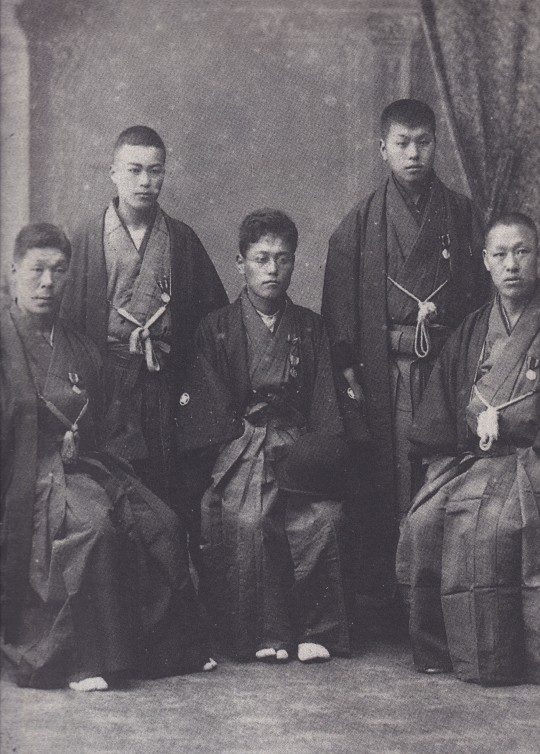

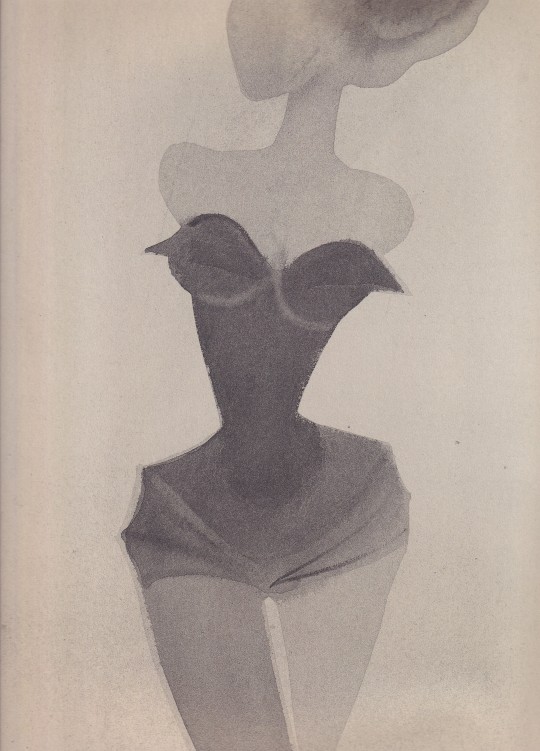
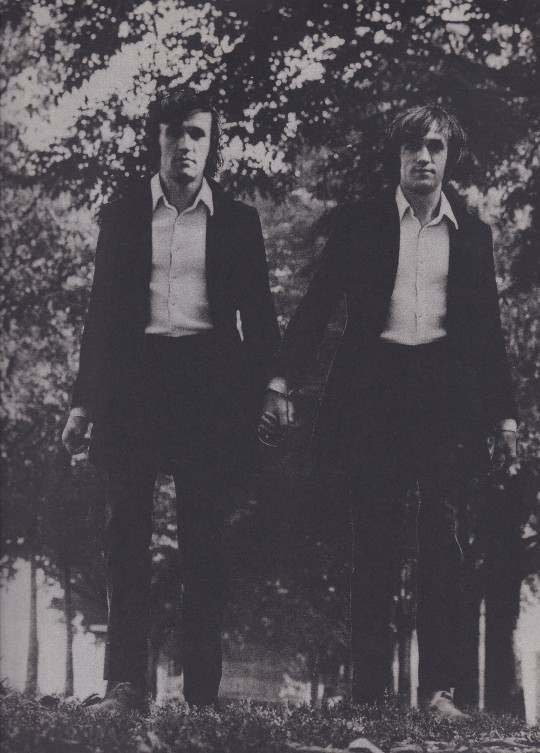
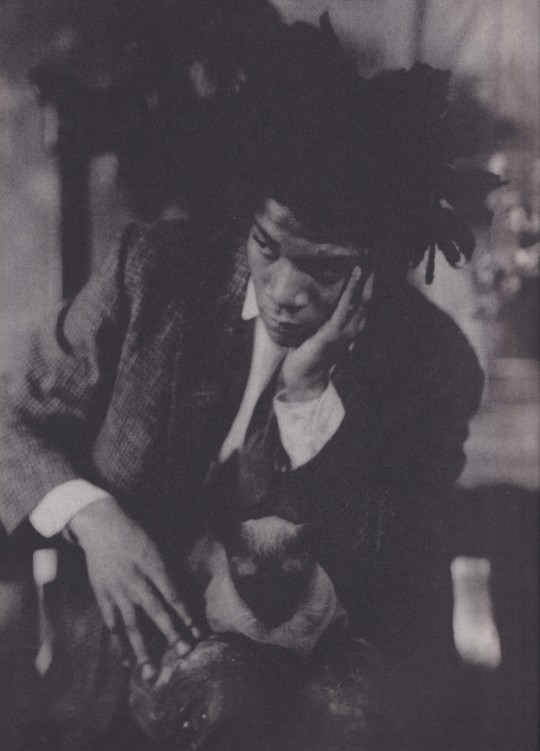
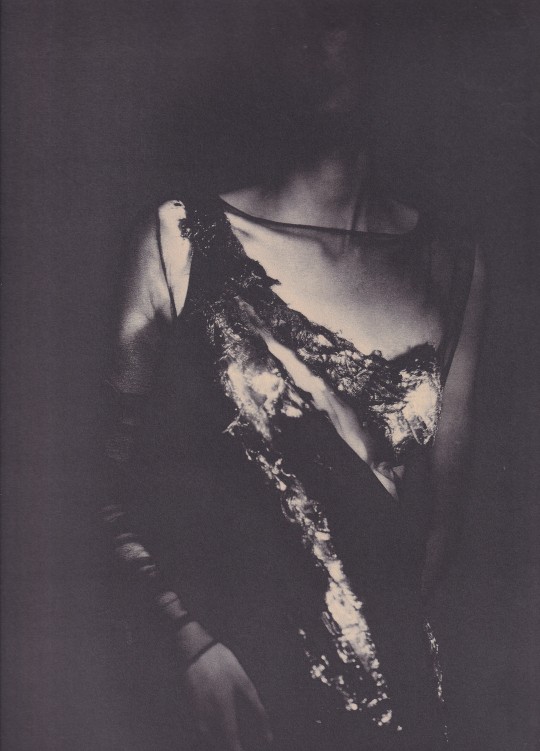


A Noir
Progetto Franca Sozzani , Direzione Artistica Luca Stoppini
Curatori Mariuccia Casadio e Pasquale Leccese
Assouline, Paris 1998, 174 pagine, 26x34cm, ISBN 2843230691
euro 80,00
email if you want to buy [email protected]
Editor-in-chief of Italian "Vogue", Franca Sozzani created this cutting-edge album as an accompaniment to the exhibition "A Noir", organized on the occasion of the Milan Trienniale in 1998. The theme "black" is the starting point for the presentation of a startling series of works by leading artists, fashion designers, photographers, architects and interior designers. From Louise Bourgeois to Damien Hirst, Rei Kawakubo to Rifat Ozbek, Mapplethorpe to Paolo Roversi, Andree Putman to Jean-Paul Goude, each featured artist reveals his or her personal interpretation of the color black, forming an anthology of images. The album includes a collection of essays and a glossary exploring the use and symbolism of black not only in art, photography and fashion, but also in literature, film and music.
12/04/24
#A Noir#Franca Sozzani#Luca Stoppini#exhibition catalogue#Triennale 1998#Louise Bourgeois#Damien Hirst#Rei Kawakubo#Ozbek#Mapplethorpe#Roversi#Goude#Andrée Putman#fashionbooksmilano
8 notes
·
View notes
Text
chapter one
Versace Fall 1994.
Desiged by Gianni Versace
Triennale Museum in Milan.
Models: Naomi Campbell, Nadja Auermann,Claudia Schiffer, Helena Christensen, Carla Bruni, Emma Wiklund, Amber Valletta, Yasmeen Ghauri, Christy Turlington.

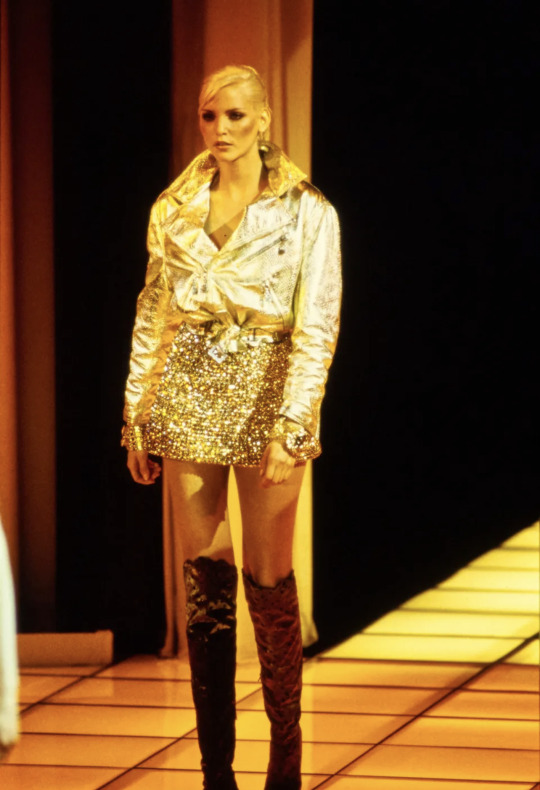



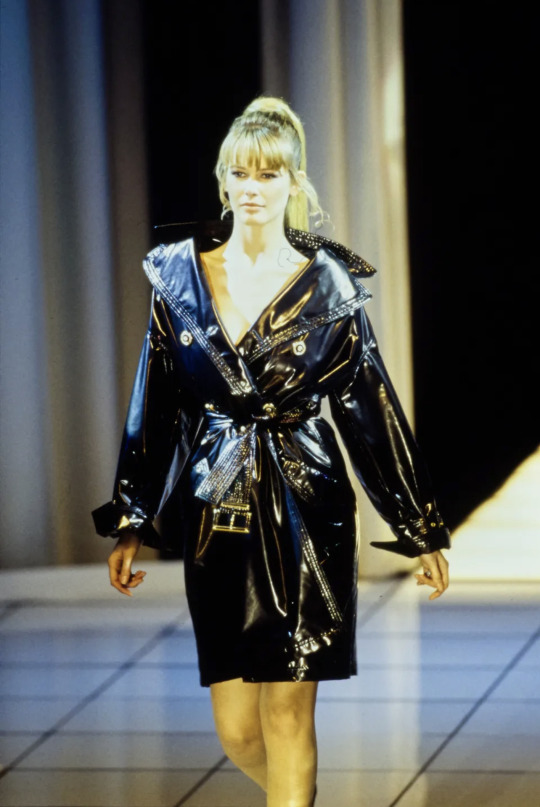
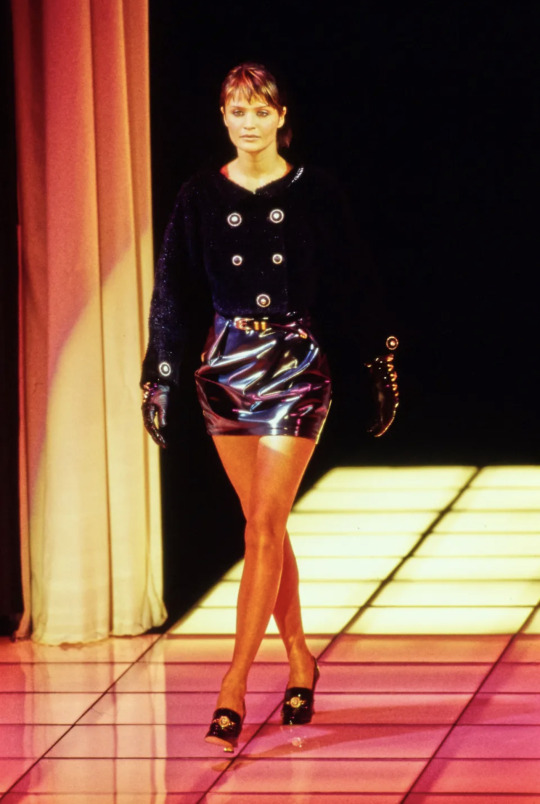
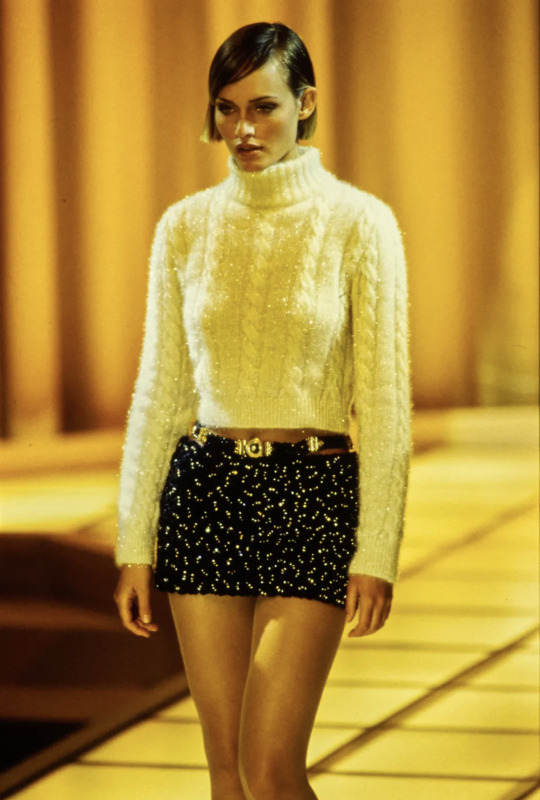

vogue.com
egypttoday.com
Alexander McQueen Spring 1998
Designed by Alexander McQueen
Gatliff Road Warehouse in London
Models: Stella Tennant, Jamie King


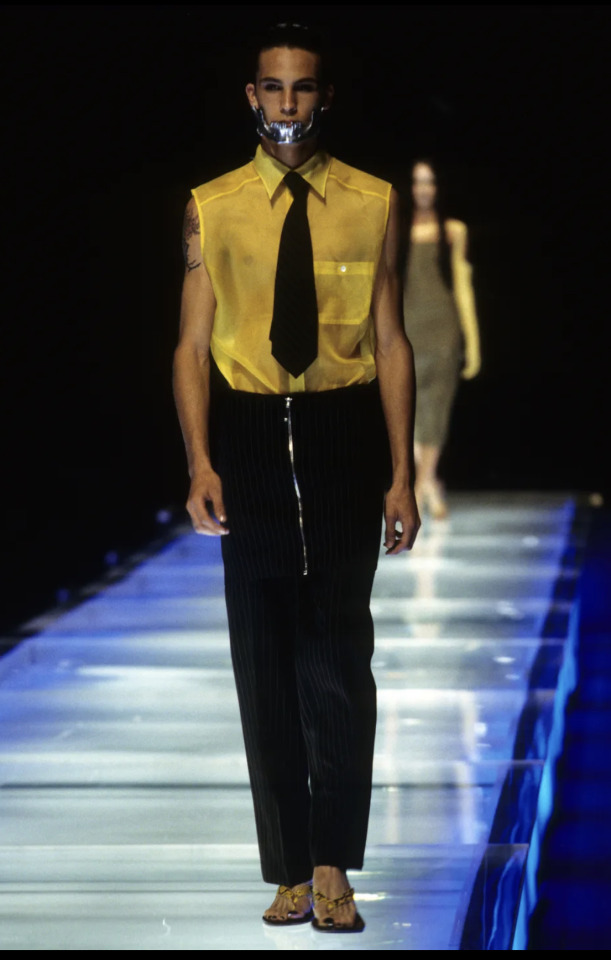
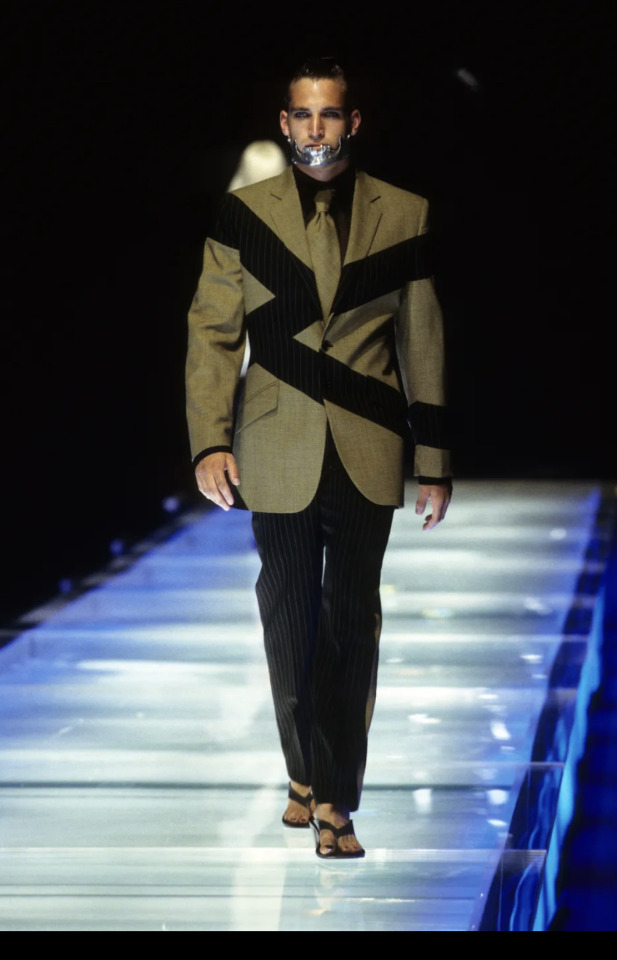

vogue.com
vam.ac.uk
Christian Dior Fall Couture 2000
Designed by John Galliano
Paris
Models: Tasha Tilberg, Diana Gärtner, Anneliese Seubert, Carmen Dell'Orefice


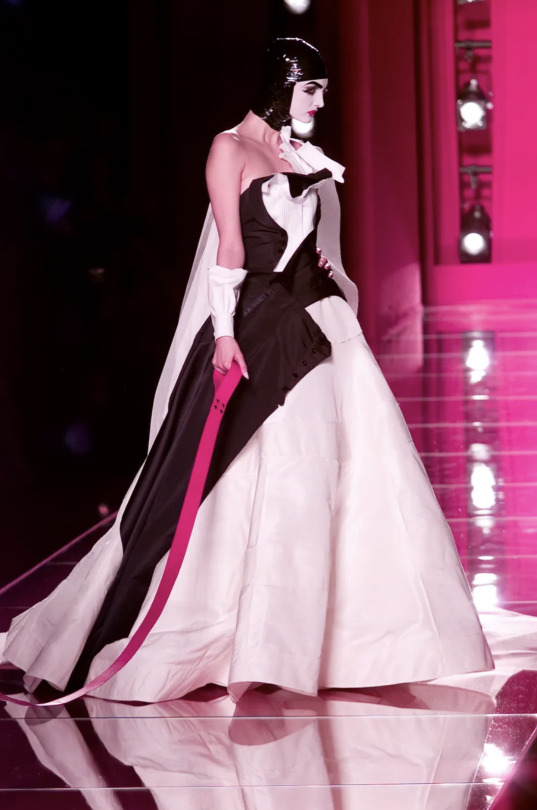

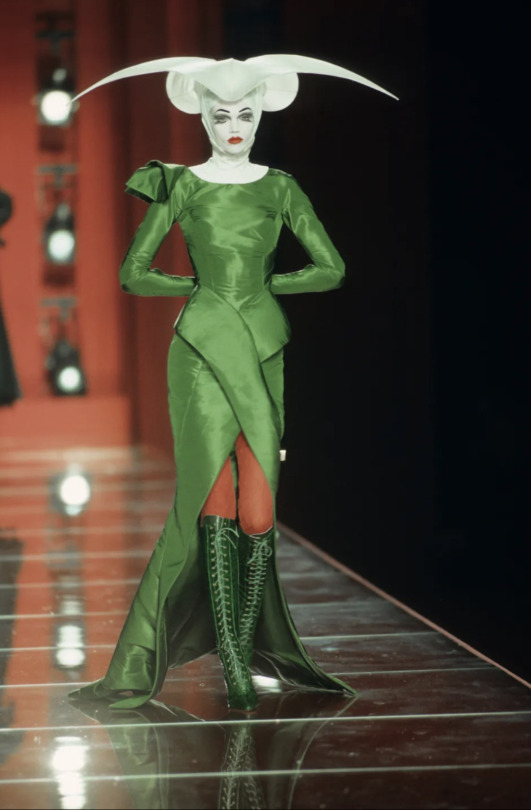


Vouge.com
Fashion Channel on Youtube
11 notes
·
View notes
Text











Sottsass Glass Works
editor Marino Barovier, Bruno Bischofberger, Milco Carboni
Vitrum, Dublin 1998, 155 pages, 29x29cm, ISBN 1 902 535065
euro 58,00
email if you want to buy [email protected]
Catalogo pubblicato in occasione dell salone "Vitrum" presso Fieramilano, Rho (MI), 1998
Contents: Glass; by Ettore Sottsass - Glass for the 8th Triennale of Milan, 1947 - Glass for Vistosi, 1974 - Glass for Memphis (first series), 1982-83 - Glass for Memphis (second series), 1986 - "15 Lamps for Yamagiwa" Series, 1990 - "Rovine" Series, 1992 - Glass for Bischofberger Gallery, 1994 - "Big and Small Works" Series, 1995 - "27 legni per un fiore artificiale cinese" Series, 1995 Glass for Venini - "Esercizi e Capricci" Series, 1998 - Biographical notes - Museums and Galleries - List of Glass Works - List of Drawings for Glass - Bibliography.
Ettore Sottsass si laurea in architettura al Politecnico di Torino nel 1939, quindi inizia la sua attività a Milano nel 1947 dove apre uno studio di design, collaborando con Giuseppe Pagano. Nel 1949 sposa Fernanda Pivano. Fa in un primo tempo parte del Movimento Arte Concreta per aderire poi allo Spazialismo. Dal 1958 inizia la sua collaborazione, che durerà per oltre trent'anni, con la Olivetti in qualità di computer design. L'anno successivo vince il Compasso d'oro, primo di una serie di importanti riconoscimenti internazionali. Nel 1980 apre lo studio "Sottsass e associati" e nel 1981 fonda il gruppo Memphis insieme ad architetti di prestigio di tutto il mondo. Vari sono i campi artistici in cui si sperimenta, in particolare nelle arti visive. Nel 1988 esce Terrazzo, rivista da lui ideata e realizzata, e che uscirà fino al 1996. Grandi mostre internazionali e grande fama: Sottsass è stato uno dei più grandi nomi del design e uno dei maggiori architetti del secolo scorso. Morì il 31 dicembre 2007
30/06/24
#Ettore Sottsass#glass works#salone Vitrum 1998#exhibition catalogue#design books#designbooksmilano#fashionbooksmilano
0 notes
Text
Mariuccia Mandelli. Krizia
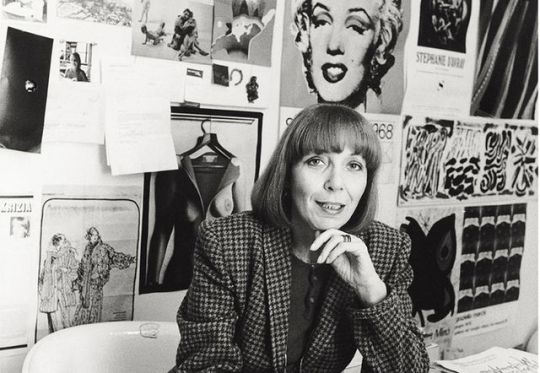
Maria Mandelli, detta Mariuccia, è passata alla storia come Krizia, il nome del suo storico brand di moda.
Stilista e imprenditrice, icona di stile nel mondo intero, ha apportato un importante contribuito alla nascita del prêt-à-porter italiano e a plasmare il look della donna moderna.
Nata a Bergamo il 31 gennaio 1925, aveva studiato in Svizzera e per qualche anno ha lavorato come maestra elementare. Ma la passione per la sartoria ebbe la meglio e abbandonando, la certezza di un lavoro fisso, decise di aprire un piccolo laboratorio con l’amica Flora Dolci. Agli inizi, andava personalmente a vendere le sue creazioni in giro per le boutique. Nel 1954 ha dato vita al marchio Krizia, nome ispirato dal titolo dell’ultimo Dialogo incompiuto di Platone sulla vanità.
In quel periodo Parigi stava perdendo il primato della monda mondiale mentre l’Italia e soprattutto la città di Firenze, avanzava.
Nel 1964 Krizia ha sfilato per la prima volta a Palazzo Pitti, conquistando il premio Critica della moda, dato fino ad allora solo a Emilio Pucci.
Nella seconda metà degli anni Sessanta, è stata una delle prime stiliste ad acconsentire a spostare la presentazione delle collezioni a Milano, contribuendo a rendere la città Capitale della Moda. Da lì il suo lavoro è stato tutto in ascesa.
Nel 1971 ha avuto l’intuizione di presentare una collezione di pantaloncini cortissimi (hot pants), con i quali si è aggiudicata il premio “Tiberio d’oro” a Capri.
Gli accostamenti arditi, l’uso di materiali insoliti come la gomma, il sughero e l’anguilla e le forme audaci le valsero il soprannome di Crazy Krizia, dalla stampa statunitense. Dopo gli abiti ha iniziato a firmare linee di occhiali e profumi diventati dei must have.
Nel 1982 ha fatto parte di un gruppo di otto stilisti internazionali inviati dal MIT di Cambridge alla mostra “Intimate architecture: contemporary clothing design“.
Nel 1985 ha trasferito la sede dell’azienda, gli atelier e lo showroom nel Palazzetto Melzi D’Eril e nella stessa strada ha aperto lo Spazio Krizia, un teatro progettato per ospitare sfilate, presentazioni ed eventi culturali. Nello stesso anno è diventata socia della casa editrice La Tartaruga.
Nel 1986, Mariuccia Mandelli è stata nominata commendatore della Repubblica italiana per aver reso famosa la moda nostrana nel mondo, unica donna insieme a Giorgio Armani, Gianni Versace, Valentino Garavani e Gianfranco Ferré.
Negli anni novanta è stata indagata nella maxi inchiesta Mani pulite, accusata di aver versato tangenti alla Guardia di finanza, è stata assolta con formula piena nel 1998.
Nel 1995, alla Triennale di Milano, è stata presentata la retrospettiva Krizia. Una storia per celebrare i suoi quarant’anni di lavoro.
Nel 1999, è stata la prima stilista ospitata nella Grey Art Gallery dell’Università di New York con la mostra Krizia, con le scenografie di Dante Ferretti (vincitore di tre Premi Oscar). Molto famosa anche in Asia, nel 2001 il Museo d’Arte Contemporanea di Tokyo ha ospitato la mostra Krizia Moving Shapes.
Ha lasciato la terra il 6 dicembre 2015, nella sua abitazione di Milano.
Mariuccia Mandelli è riuscita, con ostinazione e tenacia a coronare il suo sogno, costruire un impero e primeggiare in un mondo dominato dagli uomini. Intercettando i gusti delle persone comuni è stata pioniera nel prendere le distanze dai canoni dell’alta moda, confezionando linee per la donna del futuro: libera, forte, creativa.
Negli anni Sessanta ha vestito le donne con pullover tricottati, forme geometriche, sperimentando materiali innovativi e abbinando materiali preziosi ai tagli sportivi di abiti che dovevano vestire la quotidianità. Con il plissé, il lamé, ha creato vestiti capaci di evocare draghi, libellule, farfalle, chiocciole, simboli di quella libertà che ha sempre perseguito.
È stata tra le prime a offrire una linea curvy, adatta per ogni tipo di corporatura e a stabilire un dialogo con l’arte. Il nome del suo marchio è stato sinonimo di eleganza e libertà in ogni angolo del globo.
0 notes
Text
Rabiot, la Juve lavora ad un rinnovo triennale
GAZZETTA – JUVE, KOOPMEINERS PIACE A GENNAIO: SAMARDZIC POSSIBILE ALTERNATIVA La Juventus guarda a Teun Koopmeiners, centrocampista classe 1998 dell’Atalanta e della nazionale olandese, per rinforzare la mediana a gennaio: come riportato da “La Gazzetta dello Sport”, la principale alternativa al giocatore nerazzurro, certamente molto… QUI TUTTOSPORT – XAVIER JACOBELLI: “JUVE, ANNO ZERO: PIETRA…

View On WordPress
0 notes
Text
Interview with Artist & Photographer Xing Danwen
New Post has been published on https://china-underground.com/2020/05/29/interview-with-artist-photographer-xing-danwen/
Interview with Artist & Photographer Xing Danwen
Xing Danwen‘s subjects include conflicts between globalization and traditions, problematic environmental issues created by the development, the urban drama between desire and reality.
Xing Danwen started her visual art practice with painting medium and took a professional study at the primary art school affiliated with Xi’an Academy of Fine Arts. She continued painting and did her BFA at the Central Academy of Fine Arts in Beijing. In the late 80s, she met photography and was immediately drawn into this medium. As a self-taught photographer, she was one of a few artists in the late 80s and 90s in China that was exploring the boundaries of photography and using photography as an art form. Through the camera, she observed and challenged the questions on Chinese society, humanity, female identity, and the generation that was born in the 60s. In 1998, she went to New York with a grant and fellowship from the Asian Cultural Council. Xing Danwen exhibits domestically and internationally, including the Whitney Museum of American Art, Pompidou Center, International Center for Photography, Victoria and Albert Museum, 1st Yokohama Triennale, and Sydney Biennale 2004, etc. Her works are also collected widely by museums and privates, including Whitney Museum, Pompidou, ICP, SF MoMA, FNAC, the Progressive, Groupe Lhoist, etc. She has been awarded several important awards at home and abroad. In 2018, she was awarded the Silver trophy for the Best Artist of the Year by AAC. Also, she is listed as the 10th from “25 Asian Art Female Power” by Art Bazaar magazine Japan in 2019.
Official site
You started as a paintress and in the late 80s, you were drawn to photography. Can you tell us about your beginnings? What did it mean for your artist’s path?
My beginning was very simple. I just like to paint. Like many children. It was just a hobby, but I kept doing it and started dreaming to be an artist. At that time our education for art was very basic, just about painting and sculpture. So, making a painting, for me was a simple understanding of moving toward art. Later, when I was in art school, coincidentally I met photography by reading a photo magazine at my professor’s studio. That moment it added to my vision of making visual art. I didn’t have any photography class and I even didn’t have a camera. So my understanding of photography was also very intuitive. Photography is another medium of visual art. For me, it’s the same as a painting, just different media. What I like about photography is that the media has its own kind of language of reality. But at the same time, if it is real? Therefore, in my work, fiction and fact, and illusion and reality often play important roles.
You were part of the first generation of contemporary artists in China. You experienced an important and significant time in the art scene. How did you feel and what is your feeling now about your experience of the beginning of China’s contemporary art movement?
It was like we were looking for the way in the fog, but with strong belief and courage, brave and adventurous.
I am a Woman, ©Xing Danwen
I am a Woman, ©Xing Danwen
What were the biggest challenges during that period? Have you faced some unexpected moments that made you ask if it was your right path?
Society was very suppressed, and the mentality of the public was very closed. These made us a small group of artists without support and understanding, often under siege and without security. For example, one weekend in June 1994, after Ma Liuming’s performance at his residence, we were all arrested. Two artists, Ma Liuming and Zhu Ming were detained for more than two months, and finally convicted of pornography and repatriated. Even so, I have never doubted myself and what we have done. We are not afraid. Where there is oppression, there is resistance. This made us more courageous and motivated.
Can you tell us how the idea of “Born with Cultural Revolution” came to life? What is the story behind it?
“Born with Cultural Revolution” is part of “I am a woman” series. I separated them into two bodies in the end, because of Mao’s icon. These three images are together as a triptych. In the picture, the lady is a friend of mine from my hometown. She was born in 1966 and was pregnant with the new generation which creates layers of generation issues.
Born with Cultural Revolution ©Xing Danwen
Where did the idea for “I am a woman” come from? What did you want to communicate?
When I made this work, I was in my twenties, an age full of questions and doubts about life and love. This work is an exploration of women’s issues, especially to myself and the female gender through the bodies and eyes of my female friends.
The art critic Gu Zheng wrote in 2006:
“Xing Danwen’s I Am a Woman, of 1994-1996, boldly rejects that the female body has most often been represented under a male gaze. It can be considered one of the earliest images of nudity shot by a woman in China’s photographic history. As advocated by its title, it represented the establishment of assertive self-consciousness by a woman. In an enclosed space, Xing Danwen, through rich and varied visual angles, tricky shadows, and interwoven female bodies, concocted a private space for women, intangible for others. This pictorial space could only be shot with the mutual trust and interdependence of the women involved. Usually, it is a privilege of the man to imagine the woman and structure her image, and it is the man who is motivated to watch and present it. However, in Xing Danwen’s work, it is of a woman watching a woman, a woman defining the emotion and body of a woman. By representing the woman’s body, Xing Danwen provided for the first time a concrete shape to the existence and advocacy of the new woman in China. If these photographic images mark the wakening and consciousness of the artist as a photographer, then her photographing the female body establishes her own female identity.“
Can you share with us any meaningful stories from backstage of your art projects?
I think disCONNEXION (2002-2003) and Because I am in the Mountains (2017). When disCONNEXION was finished, the first exposure was at the Whitney Museum in New York, in an international large exhibition called “The American Effects,” which was a very controversial show criticizing how America brought so many negative effects to other countries. Regarding “disCONNEXION”, 80% of the electronic waste was shipped from the U.S.
disCONNEXION (2002-2003), photography Xing’s concerns are not only related to large cities. She has traveled to southern China to explore the effects of electronic trash recycling on villages and small cities in the Pearl River Delta in Guangdong Province. In disCONNEXION, her critical eye and sharp lens examine the aesthetics of technological waste, reflecting environmental concerns, but more importantly, anxiety about changes in the lives of workers along the south coast, whose ghosts can be sensed despite their absence from the frames.
disCONNEXION, ©Xing Danwen
disCONNEXION, ©Xing Danwen
disCONNEXION, ©Xing Danwen
Because I am in the Mountains (2017), Installation with coal coke and mixed materials This sculpture presents a panoramic miniature of a contemporary landscape made from coal coke, the synthetic material that results from burning coal. In this work, Danwen Xing creates a contrast between the polluting medium and the scene depicted. Confusion is triggered speechlessly by the divergence between the apparent disaster that is contemporary life and the beautiful vision of a natural landscape from traditional Chinese ink art. Xing expresses clear concern for the threatened nature, but more importantly, she borrows a phrase from Chinese philosophy: standing on Mount Lu means that one cannot see its true face. She engages with a visible symbolic complex, recognizing that it is impossible to observe objectively when we are lost within ourselves. Well, I choose these two bodies of work, because they share the same concern about environmental issues and a clear notion of the problematic reality under urbanization, although the works are made in a different times with different media, forms and have different artistic languages. The first is a series of photographic works, made from 2002 to 2003. This work is focused on electronic waste and the pollution caused by it. It lifts the veil of the nightmare following the development of our digital era and consumption. At that time, I was just returned from New York, and I faced constant change in Chinese cities. This was very disturbing to me because I realized how much damage was caused by rapid development. When I got an assignment from the French newspaper Libération to go to the Guangdong Shantou area, along with the Pearl River data, I immediately got my eye on the most developed economic zone and the biggest manufacturing area for “Made in China”. I focused closely on the detail of the subject with a very minimum aesthetic, only depicting the facts of the object. For one year, I had been to this region forth and back for several trips to develop this project. Through different parts of this area and villages, I saw the electronic trash was dismantled without any technical support, it was just cut, burnt, and disassembled with the bare hands without any safety protection. Millions of migrant workers and their kids just lived with these most toxic chips from the computers, and the air was full of poisonous burnt plastics, socked into the river and soil. I asked the workers if they knew how harmful to their health. They answered: “Well, we can not care so much. We are here just to make some money and later we are going home anyway.” You see, it is happening everywhere with such a short vision of the business. People work hard to make a quick profit, but at the same time damage their own life without any consciousness, and bring up more problematic issues. Many years later, in 2017, I created another work “Because I am in the Mountains”, which is a sculptural installation, made with another kind of waste: coal coke. After I had located my studio in the suburb of Beijing, I was obliged to heat up with 15 Tons of coal every winter because we didn’t have enough energy, either electricity or gas. Since then I discovered the coal coke from the stove. I found it very beautiful like a mini scholar-rock. So I started to collect them and had kept thinking to make something out of it. At the beginning of 2017, the idea got clear, which is to build a landscape, like the concept of traditional “ink art” with the coal coke. The aesthetic is a beauty of poetry, but I insert the human being’s signs and trails, such as houses, roads, and a small town, even a construction site, etc. That metaphor how urbanization is taking place everywhere in China. Nature is destroyed, the human being pollutes the living environment and the air, with or without consciousness, somehow like me. I can’t deny that I have been one of the polluters of Beijing’s air too. What a shame! Well, this work got its premiere in my 1st large-scale museum solo show “Captive of Love” at the Red Brick Art Museum in Beijing in the fall of 2017. Of course, for two years, the Government restricts using coal and every polluting material and provides a better energy level, now we all heat with a clean energy:-). The title of the work “Because I am in the Mountains” is a phrase from a very famous poem by Song Dynasty poet Su Dongpo: “when you are inside Lu-mountain, you can not see the true face of the mountain”. It is exactly a depiction of what is urbanization happening today.
Because I’m in the Mountains, ©Xing Danwen
Because I’m in the Mountains, ©Xing Danwen
Your art career is full of intimate portrayals. Is there any of your work that you are particularly connected to or that marked a significant moment or change in your personal life?
It is hard to say which one in particular. Several bodies of work have been important in different moments of my artistic development. But nothing has changed my personal life. They are all part of my artistic journey with achievements. The work “A Personal Diary” perhaps is an example of a significant moment. Different media: performance art, Photography, performance-based experimental film. In 1992, I graduated from the Central Academy of Arts and I was obliged to stop painting, only work with the camera, because my living situation was too unstable. At the same time, I met the artists unconfident Zhang Huan and Ma Liuming from the East Village in Beijing. They were very urged to be photographed by me. And I was looking for a subject for my work too. Therefore, we agreed to collaborate, since we share a mutual interest. At that time, I didn’t know what was performance art but I was curious about the difference and they were photogenic. Therefore, it came to very interesting conjunction with these three roles: photography, performance, and artwork. As my purpose was very clear I liked to make my work, instead of documenting it for others. It comes to a debate about the relationship between photography and performance art. I have never thought and intended to document the performance, but I interpreted it with my unique gaze. Many years later, I stepped into staging and acting for my work with both photography and video, including performance-based experimental films, I become more conscious of the conjunction and how the media merge, as in my museum solo exhibition “Captive of Love”, the curator Tarek Abou El Fetouh has stated comprehensively: Through photographs, installations, and videos, she positions herself inside the event, as a subject, a model, or a critical eye, creating a visual language that is both subversive and poetic.
A Personal Diary, ©Xing Danwen
A Personal Diary, ©Xing Danwen
A Personal Diary, ©Xing Danwen
A Personal Diary, ©Xing Danwen
Besides photography, you work also in the field of mixed media, video, and multi-media installations. Which of these art techniques reflect you most as an artist?
As a visual artist, I don’t like to be limited to photography. According to my idea and subject, I like to choose the most appropriate media and express well its particular language. It is part of the creative process of each new work, sometimes it causes a lot of study and experiment when it is something new technically. It is a challenge, also fun with the new experience and the new technology. I am not against anything traditional, I enjoy the hand-craft work too. Anyway, I hope I can be free and capable to use different materials and media in my works. In the past years, I didn’t work much with photography, but more with material-based work and installations, and also many more experimental short films.
How much has China changed compared to when you started your artistic career? How do you see the new art community? Do social media and new technologies help art and artist to get closer to the audience or there are new kinds of layers and filters?
A lot of changes. In the 1990s, we didn’t have many public exhibitions of contemporary art, we didn’t have a market, also we didn’t have an art press. At that time, everything was underground, secretly. The audiences were artist friends in the circle, and the artist community was very small, finger accountable. Today in China, art becomes an industry, with international art fairs, and hundreds of domestic galleries. and so many social media for the art press. Yes, there are so many exhibitions that the artists have a much better platform to display their artworks, more chances, and opportunities to be shown and seen. People from my generation become more independent, no longer grouping, and the young generation is more fit for the commercially driven art world.
Installation view of Xing Danwen’s I’m a woman, 2019 at UCCA, Beijing. ©Xing Danwen
What role gender has played in the development of Chinese contemporary art? What does it mean to be a woman artist working in China today? Does gender still matter? Are women slowly changing Chinese art?
Women in China are like everywhere in the world. They are part of society and culture. When you want to talk about Women in any country, you must understand the circumstance. In China, in 1949 Mao Zedong declared that women are half of the sky. Women and men are equal socially stated in China. Women are encouraged to work and go to school the same as men. But where does the imparity come from? The answer is tradition which is the fundamental problem. China is still a macho society. Men are dominant. Virtually, what is standard for a good woman, traditionally everywhere is the same: to be a good wife as a servant, to be a good mother as a maid, and to be a good partner as a capable assistant.
Anyway, a woman should never consider herself and what she needs. In general in my generation, when women are independent, smart, especially economically independent, it would never be considered the best choice for a wife. But not every man is this way, and the new generation is different, I think. The new generation in China is very different from mine because they’re all from one-child families, which means he or she is a king or queen:-) They are the center, get all of the attention from the parents and families. The parents would give the kids the best education and material life, whatever the parents didn’t have. Today in art schools, there are more female art students than males. Perhaps, they are more female artists now but in general, still not many.
Well, whatever, I like to advise that a woman wants to be truly independent, only to be smart with an independent mind is not enough; she has to first gain economic independence. Talking about women artists, I think it is difficult in any country and any time because it’s a very independent, intelligent, and competitive profession. It requests a lot of struggles and challenges. Especially with my generation in China, they were very few women artists. Besides the tradition, there are some essential natures and features we should understand about women in general. Here are some of my analyses.
Urban Fiction (Xing Danwen), ©Xing Danwen
1st, Emotion, and love. How to transform and convert the feelings into a creative idea or art-making? I have been observing in my own life, often a woman artist makes a strong voice when she is in an emotional hardness; but when she finally found her love and is happily located, her work lost the edge. Do you understand what I mean? It seems that her emotion got another path to be expressed, not in artwork anymore.
2nd, Focus, and concentration. One of a woman’s nature is nursing and nurturing. Often, a woman enjoys taking care of the family and her loved ones, at the same time she got distracted from her focus when she is not capable to manage her time and energy. After some time, she might lose the track of her career, and not be able to catch up, become unconfident.
3rd, Persistence, and courage. As we know, being an independent artist is with lots of pressure and competition. If you don’t work hard and fight against the difficulties and your limits, you won’t be able to approve of yourself. Believe in your heart with ambitions, don’t easily give up on any frustration, never lose your strength and direction. Compared with men, women are somehow easier to give up.
After all, it doesn’t matter for a man or a woman artist, to be a real good artist, this profession requests intelligence and a strong mind, aside from the skills and techniques. Therefore, the quality of the artwork counts! I was born during the Cultural Revolution and I grew up, under the official promotion of “Men and Women are Equal: a woman is half of the sky”. Among my five-member family, I have a younger sister, my parents, and my grandmother. My grandmother was born in the revolution of 1911 in a family-owned old-style private school.
Installation view of Xing Danwen’s A Personal Diary, 1993–2003, at Red Brick Art Museum, Beijing, ©Xing Danwen
So she had an education and graduated in her senior middle school. The only man in my family is my father who actually is the quiet one, instead, all of the women have strong characters 🙂 My grandmother was a very strong independent woman. She married a very nice man who was a big engineer in the garment industry, but unfortunately, he had died too early from a medical accident at forty. So my grandmother was alone and brought up my mother. She worked as an accountant in a factory, supported my mother in studying, completing her university. From the beginning, she always said, a good education is extremely important for a woman. We should first establish a profession and become economically independent before settling into a family. It is quite unusual in my generation, I think. So I grew up in such a family. I never feel that I’m second sex. I don’t have any doubt about equality with a man. In school, I was always at the top. And I am always in the best schools. But, please don’t think I am a lucky one. No, life has never been easy for me, as an artist, as a person, and as a woman. But I always worked very hard with both art-making and making a living. And I enjoyed the experience and struggles. I didn’t fight in the sense of being a woman, I’m more fighting to be a confident person and a good artist.
Also, you may ask me, what about love in life being a woman? I have been very clear since the beginning that I won’t give up myself for a man. I want to be myself. The man who loves me should respect and like who I am. I like to be friends with the man, and I have learned a lot from them too. I think the most important is to be fair and equal to each other.
If you could go back and tell yourself one thing before beginning your career what would it be?
To be an artist!
Photos courtesy of Xing Danwen
#ChinesePhotographer, #ChinesePhotography, #MaLiuming, #ZhuMing
2 notes
·
View notes
Text
BIO/CV
Davide Mariani, nato a Cagliari (IT) il 3/10/1998. Vive attualmente a Serrenti (Sud Sardegna- IT). Ha vissuto e studiato a Sassari presso la triennale di Pittura all’Accademia di Belle Arti di Sassari dal 2018 al 2022. Attualmente frequenta il biennio specialistico Arti Visive all’Accademia di Belle Arti di L’Aquila. Operatore culturale presso l’Associazione SUONA di Serrenti.
Formazione
2022- diploma accademico di I livello Pittura presso l'Accademia di Belle Arti "Mario Sironi" di Sassari
2018- diploma in arti figurative presso Liceo Artistico “Foiso Fois” Cagliari
Rassegne d'arte contemporanea
2023 - Organica a cura di Giannella Demuro (Ass. Tramedarte) - Spazio CEDAP - Tempio Pausania - IT
Residenze
2023 a breve – Contemporary Festival di Arte e Avanguardia VIII Edizione a cura di Maurizio Coccia e Roberto Follesa - Donori – Cagliari - IT
2022 - Trameuropee, interscambio tra Italia e Macedonia del Nord a cura di Ottovolante Sulcis col patrocinio di MAECI (IT - MK) - Atinska 2 – Skopje – Macedonia del Nord
2022- Frees a cura di Paolo Carta e Cristina Meloni- Studio Terzomolare- Cagliari- IT
Selezione mostre personali
2023 a breve - Maps a cura di Mariolina Cosseddu - Spazio CEDAP - Tempio Pausania - IT
2023 - Donori Endurance a cura di Maurizio Coccia e Mario Consiglio - Palazzo Lucarini Contemporary – Trevi (Perugia) - IT
2022 - 30680 PASSI 18 KM A/R open studio a cura di Paolo Carta e Cristina Meloni- Studio Terzomolare- Cagliari- IT
Selezione Mostre Collettive
2023 - Influmine Accademie in Abbazia a cura di Andrea Aquilanti, Graziano Menolascina e Sergio Pimpinelli - PRAC Centro per l’Arte Contemporanea (Abbazia di Sant’Andrea in Flumine ) – Ponzano Romano (Roma) – IT
2023 - Ingannare Viaggio Serra Emerge a cura di Chiara di Carlo in collaborazione col collettivo Contempostranea - Serramonacesca (Pescara) – IT
2022 - A/R Cagliari-Skopje a cura di Chiara Caredda e Claudio Rosa (Ass. Ottovolante Sulcis) - Atinska 2 – Skopje – Macedonia del Nord
2022 - SONO satellite opere nell'opera a cura di Marcello Cinque, Alice Mocci, Ilaria Bacchis, Giuseppe Cossu e Alessio Ollargiu- Mas.Edu Museo d'arte Contemporanea (Sassari) IT
2022 - Menhir a cura di Milco Carboni e Pier Paolo Luvoni-Museo Mar Pozzo Podestà- Argentiera (Sassari) IT
2021 - Premio Nazionale delle Arti XV edizione a cura dell'Accademia di Belle Arti di Sassari (Antonio Bisaccia) - Mas.Edu Museo d'arte Contemporanea Sassari- IT
Stage, seminari e workshop
2023 - Una Sonnolenza Febbrile stati generali dell’arte contemporanea in Umbria a cura di Maurizio Coccia e Mara Predicatori - Palazzo Lucarini Contemporary – Trevi (Perugia) - IT
2022 - Le storie dello Chthulucene a cura di Isabella Pinto- Maxxi Museo delle arti del XXI Secolo – L’Aquila - IT
2022 - Laboratorio Esplorazione Collettiva #1 a cura del Collettivo Transhumanza - Parco di Molentargius – Cagliari – IT
2022- Lo spazio della luce seminario condotto da Mandalaki Design Studio a cura di Milco Carboni e Pier Paolo Luvoni- ArtLab Accademia Sironi- Museo Mas.Edu- Sassari-IT
2021 - riprese e montaggio del video-documentario del Contemporary Festival di Arte e Avanguardia VII Edizione
Pubblicazioni
2023 - Da Serrenti a Trevi: la mostra d’arte contemporanea di Davide Mariani di Fabiola Corona su La Gazzetta del Medio Campidano (articolo)
2022 - Gli artisti sardi si sono ispirati a Skopje - La Macedonia ricambia la visita di Vesna Ivanovska-Ilievska su Umno.mk (articolo)
2022- AL Mas.Edu. la mostra “S.O.N.O. – Satellite Opere Nell’Opera” di Tiziana La Redazione su Sardegna Reporter (articolo)
2021- SONO Satellite Opere Nell'Opera- h_demia.ss/press- Sassari (rivista)
2021- Premio Nazionale delle Arti XV- h_demia.ss/press- Sassari (catalogo)
1 note
·
View note
Photo


Mariele Neudecker
« Unrecallable Now » (1998); mixed media incl. 18 000 l of water solution, fiberglass
850 x 1950 x 120 cm. Henry Moore Fellowship commission installation at Spike Island, Bristol, UK; installation Melbourne International Biennial, Melbourne, Australia (1999); installation Yokohama International Triennale of Contemporary Art, Japan (2001).
http://acasculpture.blogspot.com/2011/11/mariele-neudecker-paysages.html
2 notes
·
View notes
Text
RETROSPETTIVA di MAURO MOLINARI “TEXTURES - Racconti e trame per un immaginario gentile”
Comunicato stampa
SPAZIO OPHEN VIRTUAL ART GALLERY
RETROSPETTIVA di MAURO MOLINARI
“TEXTURES - Racconti e trame per un immaginario gentile”
Ciclo di opere ispirate ai motivi tessili con opere del 1994 - 2007
a cura di Sandro Bongiani
Preview: 4 dicembre 2020
dal 5 dicembre 2020 al 14 marzo 2021
L’evento partecipa alla giornata del contemporaneo
promossa da AMACI
Associazione dei Musei d'Arte Contemporanea Italiani
#GiornataDelContemporaneo
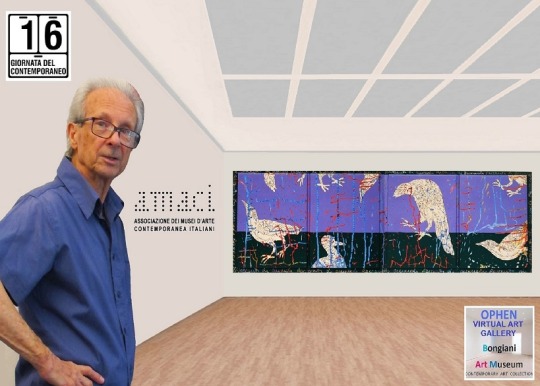

S’inaugura sabato 5 dicembre 2020, alle ore 18.00, la mostra Retrospettiva “TEXTURES - Racconti e trame per un immaginario gentile”, dedicata a Mauro Molinari, con 72 opere dal 1994-2007, che cerca di fare il punto sulle proposte tessili e immaginative dell’artista romano. In questa retrospettiva l’autore ci introduce nel mondo del linguaggio simbolico, nei racconti e tra le trame di un immaginario gentile dove ogni cosa sottesa racchiuse un senso, anche se possiamo percepirlo soltanto come una suggestione “appena trascritta” con il procedimento antico dei tessuti e carte utilizzate, rievocando lontani richiami per divenire suggestioni poetiche di una realtà sempre più evocativa e immaginaria.
Il percorso di Mauro Molinari, in circa un cinquantennio di lavoro, è contrassegnato da cicli diversi, come quelli dedicati all’informale, alla poesia visiva, ai libri d’artista, alla reinterpretazione degli antichi motivi tessili e nell’ultimo quindicennio al racconto della realtà urbana. Una lunga e appassionata ricerca contrassegnata da momenti diversi, tra filo, trama, intreccio e contrappunto, con un’attenzione assidua sulla presenza che apre un varco nel tempo e sul vuoto spaziale in un intreccio di momenti e tempi diversi alla ricerca della relazione e dell’equilibrio per manifestarsi. Alla fine, l’intreccio diviene filo conduttore di storie e di significati che si dipanano in un viaggio carico di suggestioni e vibrazioni poetiche suggerite per frammenti di senso.
A partire dagli anni 90, i motivi tessili rielaborati come segni, frammenti e presenze simboliche di forme naturali, vegetali e persino araldiche prendono forma fantastica su carte e tele, su preziosi libri d’artista, teatrini, abiti di carta, scarpe, cravatte e anche paramenti liturgiche, paliotti e pianete.
Sandro Bongiani nella presentazione in catalogo scrive: “Un universo assai complesso dettato da una specifica motivazione alla ricerca dell’invenzione creativa e dell’interpretazione fantastica. Il tutto avviene in circa 15 anni di lavoro con una pittura lieve e insostanziale che si deposita sulla pelle velata e fragile della carta per divenire sfuggente apparizione.
Libri teatro di carta dipinta su tessuto, libri oggetto, libri giocattolo, libri a rilievo da aprire e libri d’artista non sfogliabili che purtroppo non possiamo mai aprire, nelle sue mani tutto diventa favola e racconto ordito tra filamenti e trame di apparizioni che si stabilizzano nello spazio provvisorio della pittura, in un tempo sospeso e precario in cui l’immaginazione s’incarna alla ricerca dell’invenzione. Da questo incanto nascono presenze assorte nate tra le trame e i vagiti di remoti tessuti per divenire delicati racconti poetici di una realtà tutta contemporanea.
Una lunga e proficua stagione creativa “tessile” in cui l’artista è intento a indagare in modo assiduo un possibile recupero della memoria e a svelare le simbologie e i grovigli della vita con una verve visionaria in cui le coordinate del tempo e dello spazio si dilatano e perdono le loro abituali caratteristiche logiche in vista di nuove associazioni e traiettorie. La traccia di un suggerimento di memoria può ora finalmente distendersi tra la fragile carta e i brani di tessuto reale e divenire “ordito gentile”, trama e frammento di racconto che si libera dalle costrizioni in una narrazione a più livelli di lettura che s’intersecano e convivono. Solo in questo modo i frammenti del passato possono prendere forma e divenire materia lirica in rapporto alla vita, in un succedersi cadenzato e assorto di accadimenti e di intrecci allusivi che emergono da un tempo remoto per divenire contemporaneità e soprattutto essenza concreta di assoluto”.
BIOGRAFIA
Mauro Molinari Nato a Roma, vive a Velletri (RM). La sua ricerca artistica si è svolta per cicli che vanno dai registri informali degli anni ’60 alla pittura scritta e alle geometrie modulari del ventennio successivo. Nel 1974 personale alla galleria d’Arte Internazionale di Roma, pres. S. Giannattasio. Nel 1975 le sue opere sono presenti alla X Quadriennale di Roma. Dal 1974 all’81 partecipa alle rassegne internazionali sul disegno della Fundació Joan Miró di Barcellona. Nel 1979 personale alla galleria Il Grifo di Roma , pres. D. Micacchi. Nel 1982 personale alla galleria Il Luogo di Roma, pres. M. Lunetta e C. Paternostro. Nel 1983 e 1985 partecipa all’International Drawing Biennale di Cleveland. Nel 1987 personale alla galleria Incontro d’Arte di Roma, pres. I. Mussa. Negli anni ’90 si dedica alla rielaborazione pittorica dei motivi tessili avviando un ciclo che dura più di 15 anni. Nel 1995 nasce la collana di Orditi & Trame, di cataloghi editi in proprio. Il primo illustra la mostra itinerante promossa dalla Tessitura di Rovezzano e presentata a Roma alla galleria Pulchrum, pres. L. de Sanctis. Nel 1998 personale allo Spazio de la Paix e alla Biblioteca Cantonale di Lugano, pres. A. Veca. Dal 2000 al 2014 partecipa ai Rencontres Internationales di Marsiglia. Dal 2000 al 2008 collabora con la rassegna internazionale Miniartextil che si tiene a Como ogni anno. Nel 1999-2000 crea il ciclo Stellae Errantes sculture dipinte ispirate ai tessuti sacri, che è stato ospitato in numerosi musei italiani in occasione del Giubileo. Nel 2001 personali alla galleria Il Salotto di Como e al Museo Didattico della Seta di Como, pres. M. De Stasio. Nel 2001 personale al Museo dell’Infiorata di Genzano, pres. C. F. Carli. Nel 2002 personale al Museo S. Maria di Cerrate Lecce, pres. L. Caramel. Nel 2003 sala personale al Musèe de l’Impression sur Ètoffes di Mulhouse, pres. L. Caramel. Nel 2004 personale a Oman Caffè di Como, pres. L. Caramel. Nel 2005 esposizione allo Spazio Mantero di Como e al Salons de l’Hôtel de Ville di Montrouge, pres. L. Caramel. Nel 2006 Salone d’Arte Moderna di Forlì, pres. F. Gallo, e sala personale al Museo di Palazzo Mocenigo di Venezia, pres. L. Caramel. Nel 2007 personale alla Fondazione Venanzo Crocetti di Roma, pres. C. F. Carli e C. Paternostro. Nel 2008 sala personale alla VI Triennale Internazionale di Tournai, e personale alla Biblioteca Angelica di Roma, pres. E. Di Raddo. Dal 2008 sviluppa un ciclo pittorico dove è centrale la figurazione, che si pone come naturale evoluzione del suo percorso creativo. Nel 2009 personale alla galleria Renzo Cortina di Milano, pres. A. Veca. Nel 2010 personale al Museo Carlo Bilotti di Roma, pres. A. Arconti e L. Canova. Dal 2011 al 2016 e 2019 partecipa al Festival del Libro d’Artista di Barcellona, pres. E. Pellacani. Nel 2012 e 2015 Galleria Gallerati Roma primo e secondo progetto mixed media. Nel 2013 due personali alla galleria Baccina Techne di Roma, pres. G. Evangelista e personale allo Spazio Ophen Virtual Art Gallery di Salerno, pres. G. Bonanno. Nel 2014 personale allo Spazio COMEL di Latina, pres. M. Cozzuto e a Roma presso il Municipio Roma III, Aula Consiliare, pres. G. Evangelista. Nel 2016 Dante e i Papi nella Divina Commedia Fondazione Pescabruzzo a cura di Giorgio Di Genova, donazione delle opere. Dal 2014 al 2019 Artisti per Nuvolari Casa Museo Sartori Castel d’Ario (MN). Nel 2017 Museo Jean Lurçat Angers Francia, donazione bozzetto originale. Personale Spazio Medina e AF CasaDesign pres. F. Farachi. Antologica 1990/2006 Museo Diocesano e Sala Angelucci Velletri, pres. Sara Bruno e Claudia Zaccagnini, donazione di sei sculture. Nel 2018 donazione di un’opera al costituendo museo di arte contemporanea SAmac di Benevento, Antologica 2007/2017 Tibaldi Arte Contemporanea Roma a cura di Carlo Fabrizio Carli. Nel 2019 il Museo Comunale di Praia a Mare ha acquisito l’opera “White and Brown. Nel 2020 Retrospettiva “Textures - Racconti e trame per un immaginario gentile” , Ciclo di opere ispirate ai motivi tessili con opere del 1994 - 2007 - Spazio Ophen Virtual Art Gallery di Salerno a cura di Sandro Bongiani
Studio: Interno 5, via Paolina 25, 00049 Velletri (RM) Italia, info: cell. 328 6947561 www.facebook.com/mauro.molinari.73 e-mail: [email protected] web: www.mauromolinari.it sito web storico: www.caldarelli.it/molinari.htm
SPAZIO OPHEN VIRTUAL ART GALLERY - SALERNO
COLLEZIONE BONGIANI ART MUSEUM
http://www.collezionebongianiartmuseum.it
Orario continuato tutti i giorni dalle 00.00 alle 24.00
http://www.collezionebongianiartmuseum.it/sala.php?id=14
http://www.collezionebongianiartmuseum.it/sala.php?id=89
2 notes
·
View notes
Text
Campi, Gandola: Villa Montalvo, edificio fatiscente

Il Capogruppo di Forza Italia a Campi Bisenzio Paolo Gandola: "Villa Montalvo, edificio fatiscente. E' grave non aver candidato il compendio ai fondi del PNRR" "Le condizioni di fatiscenza del compendio di Villa Montalvo non sono più sostenibili, è urgente inserire il restauro della villa nel piano triennale delle opere pubbliche e valutare se sia possibile candidare il compendio per ottenere le risorse del Pnrr, così come stanno facendo tanti Comuni della Piana Fiorentina che stanno candidando tante ville, immobili ed edifici di proprietà comunale avendo elaborato specifiche progettualità". Così si esprime Paolo Gandola, capogruppo di Forza Italia e consigliere metropolitano che spiega: “nel dicembre scorso avevo chiesto informazioni al riguardo presentando un’interrogazione in consiglio comunale. La risposta dell’assessore Loiero è stata che che al momento il restauro del compendio non è inserito nel piano triennale delle opere pubbliche non esistendo alcuna progettualità specifica di riqualificazione, sebbene di volta in volta ci siamo interventi di manutenzione ordinaria e straordinaria per garantire la sicurezza dell’immobile, che accoglie uffici pubblici e la Biblioteca, oltre alla cappella con le spoglie di Felice Matteucci, inventore, con padre Barsanti, del motore a scoppio. Questo disinteresse della Giunta verso la Villa non è più tollerabile, continua Gandola, l’ultimo restauro della Villa è avvenuto nel 1998, ben 24 anni fa, ed oggi si assiste ad un grave degrado con infissi deteriorati ed una facciata completamente ammalorata con infiltrazioni d’acqua quotidiane. Anche sulla Biblioteca, la Giunta non ha fatto nulla di ciò che aveva promesso, l’orario di apertura non è mai stato potenziato, consentendo di aprire anche il sabato e gli spazi per studenti e fruitori sono oltremodo ristretti, fatiscenti ed angusti, soprattutto rispetto alle biblioteca comunale del circondario che godono di location all’avanguardia. Insomma, conclude Gandola, i tempi oramai si stanno per esaurirsi ed è grave che la Giunta non abbia fatto nulla per candidare il restauro dell’immobile ad ottenere le risorse del Pnrr. È necessario procedere ad individuare una progettualità complessiva con la predisposizione di un piano di fattibilità tecnico ed economico del restauro, altrimenti, in assenza di tale documento, non sarà mai possibile trovare le risorse necessarie. Si tratta di un compendio storico importante, già residenza della famiglia Ramirez De Montalvo ed è più possibile lasciare questo luogo all’abbandono". Paolo Gandola, Capogruppo di Forza Italia a Campi Bisenzio






Read the full article
0 notes
Text


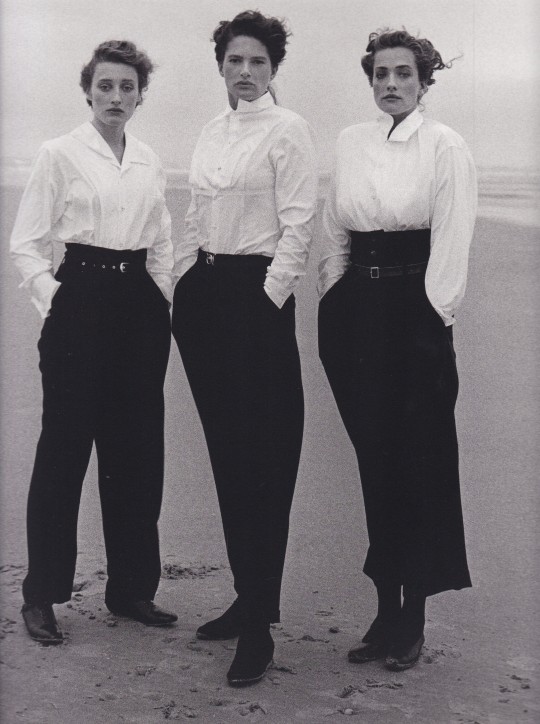
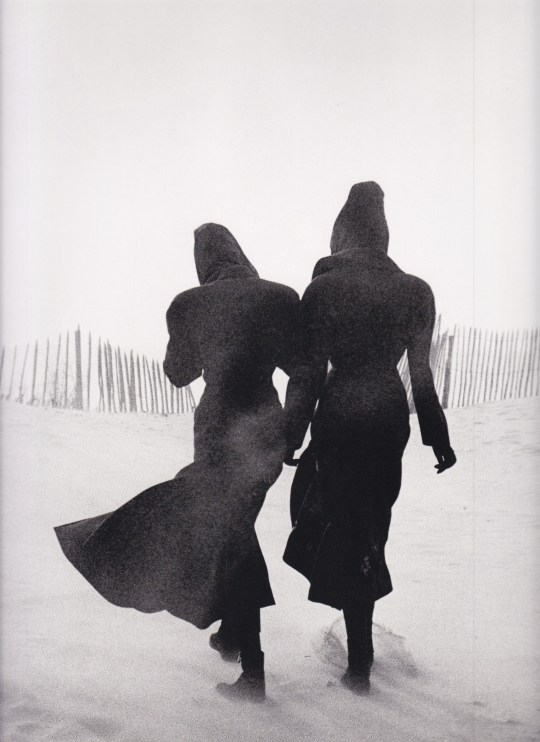

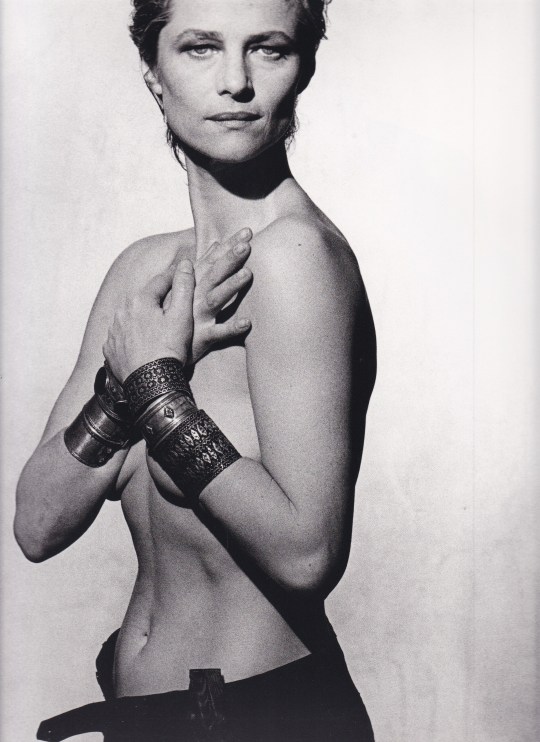

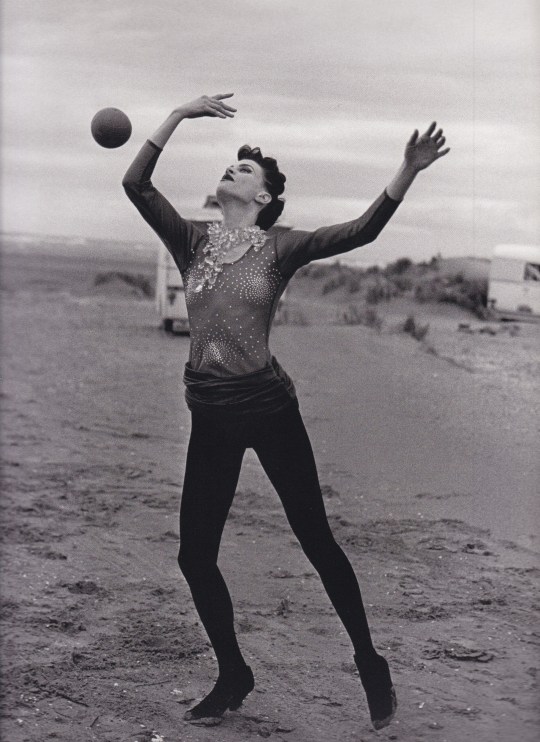


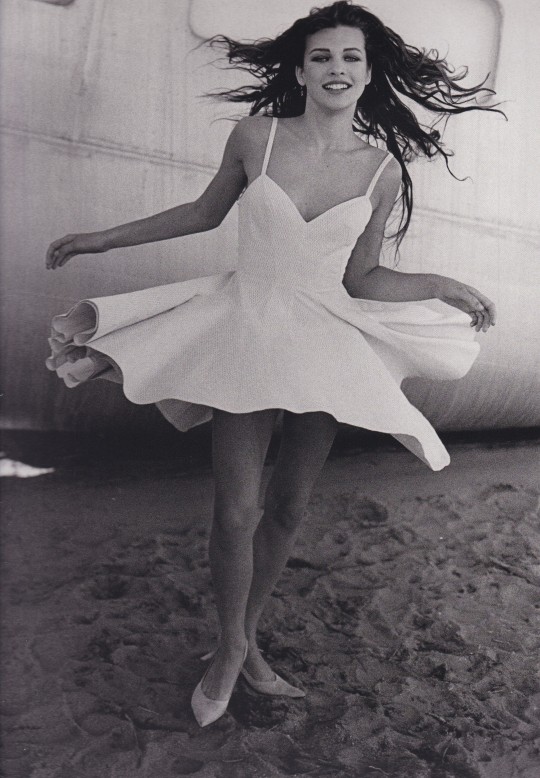
Peter Lindbergh
text by Martin Harrison
Schirmer/Mosel, Munich 1998, 96 pages, 25 x 38,5 cm, Softcover, ISBN 3-88814-117-6, English text
euro 120,00
email if you want to buy [email protected]
Mostra Triennale Milano 6 marzo 12 aprile 1998 a cura di Franca Sozzani, direzione artistica Luca Stoppini
A very rare and beautiful catalogue published on the occasion of the exhibition "Peter Lindbergh", organized by La Triennale di Milano, Milan. Peter Lindbergh (1944 - 2019) was one of the most significant and sought after fashion photographers of the past forty years, and was closely associated with the rise of the ‘supermodel’ during the 1980s.
Les photographies de Peter Lindbergh paraissent dans les magasines Vogue, Marie Claire, Stern, Allure, ou encore Harper's Bazaar. L'ouvrage reproduit en trés grande partie des photographies en noir, en pleine page, de nus ou de portraits
18/06/23
orders to: [email protected]
ordini a: [email protected]
twitter:@fashionbooksmi
instagram: fashionbooksmilano
designbooksmilano
tumblr: fashionbooksmilano
designbooksmilano
#Peter Lindbergh#photography exhibition catalogue#Triennale Milano 1998#Franca Sozzani#Luca Stoppini#Vogue#Harper's bazaar#Stern#Allure#Marie Claire#black & white photography#fashion books#fashionbooksmilano
31 notes
·
View notes
Photo

Rafael Lozano-Hemmer and Krzysztof Wodiczko
Friday, September 7, 2018, 7pm Le vendredi 7 septembre à 19 h Concordia University Sir George Williams University Alumni Auditorium (H-110) Pavillion Henry F. Hall, 1455 Boul. de Maisonneuve O. https://goo.gl/maps/YkXMyhedwbN2 www.finearts.concordia.ca In connection with the current exhibition Rafael Lozano-Hemmer, Unstable Presence, Conversations in Contemporary Art is proud to partner with the Musée d’art contemporain de Montréal (MAC) to present a conversation between artists Rafael Lozano-Hemmer and Krzysztof Wodiczko, who collaborated on the production of Zoom Pavilion (2015). Admission for all Conversations in Contemporary Art events is free and open to the general public. Seating is first come, first served. The lectures are held in English.
+ Rafael Lozano-Hemmer Rafael Lozano-Hemmer was born in Mexico in 1967. He was the first artist to represent Mexico at the Venice Biennale, with an exhibition at Palazzo Van Axel in 2007. He has also shown at biennials and triennials in Cuenca, Havana, Istanbul, Kochi, Liverpool, Melbourne (National Gallery of Victoria), Montreal, Moscow, New Orleans, New York (International Center of Photography), Seoul, Seville, Shanghai, Singapore and Sydney. Lozano-Hemmer’s artistic production has been the subject of monographs and performances in numerous institutions, including MUAC in Mexico City (2015), SFMOMA (2012), the Museum of Contemporary Art in Sydney (2011), the Manchester Art Gallery (2010), the Guggenheim Museum (2009) and the Barbican Centre in London (2008). Krzysztof Wodiczko Born in 1943 in Warsaw, Krzysztof Wodiczko lives and works in New York, Boston and Warsaw. Since the early 1980s he has produced more than eighty public projections in Australia, Austria, Canada, England, Germany, Holland, Northern Ireland, Israel, Italy, Japan, Mexico, Poland, Spain, Switzerland and the United States. At the same time, he has been designing and implementing a series of nomadic instruments and vehicles with homeless, immigrant and war veteran operators, for their survival and communication. Wodiczko won the Hiroshima Art Prize in 1998 for his contribution as an international artist to world peace, and has represented Canada and Poland at the Venice Biennale. He is Professor of Art, Design, and the Public Domain at the Harvard Graduate School of Design. http://www.lozano-hemmer.com/ https://www.krzysztofwodiczko.com/ + Dans le cadre de l’exposition Rafael Lozano-Hemmer. Présence instable, le Musée d’art contemporain de Montréal (MAC) en partenariat avec le programme CICA présentent une conversation entre les artistes Rafael Lozano-Hemmer et Krzysztof Wodiczko, qui ont collaboré à la création de l’œuvre Zoom Pavilion (2015). Tous les événements du programme Conversation in Contemporary Art sont gratuits et ouverts au public. Les sièges sont assignés selon le principe du premier arrivé, premier servi. Les conférences se dérouleront en anglais. Rafael Lozano-Hemmer Rafael Lozano-Hemmer est né à Mexico en 1967. Il a été le premier artiste à représenter le Mexique à la Biennale de Venise, avec une exposition au Palazzo Van Axel en 2007. Son travail a également été exposé dans les biennales et triennales de Cuenca, La Havane, Istanbul, Kōchi, Liverpool, Melbourne (National Gallery of Victoria), Montréal, Moscou, La Nouvelle-Orléans, New York (International Center of Photography), Séoul, Séville, Shanghai, Singapour et Sydney. La production de l’artiste a fait l’objet de présentations monographiques et de performances dans de nombreuses institutions, parmi lesquelles le MUAC de Mexico (2015), le SFMOMA (2012), le Museum of Contemporary Art de Sydney (2011), la Manchester Art Gallery (2010), le Guggenheim Museum (2009) et le Barbican Centre de Londres (2008). Krzysztof Wodiczko Né à Varsovie en 1943, Krzysztof Wodiczko vit et travaille à New York, Boston et Varsovie. Au cours de sa carrière, il a réalisé plus de quatre-vingts œuvres de projections publiques en Allemagne, en Angleterre, en Australie, en Autriche, au Canada, en Espagne, aux États-Unis, en Irlande du Nord, en Israël, en Italie, au Japon, au Mexique, aux Pays-Bas, en Pologne et en Suisse. En même temps, il a notoirement conçu et mis en pratique une série d’instruments et de véhicules nomades avec des opérateurs sans-abri, immigrants et vétérans de guerre dont ceux-ci se servent pour survivre et communiquer. Wodiczko s’est mérité le Hiroshima Art Prize en 1998 pour sa contribution, en tant qu’artiste international, à la paix dans le monde, et il a représenté le Canada et la Pologne à la Biennale de Venise. Il est professeur en art, design et domaine public à la Harvard Graduate School of Design. http://www.lozano-hemmer.com/ https://www.krzysztofwodiczko.com/
3 notes
·
View notes
Link
20 set 2021 16:59
E MENO MALE CHE I MEDICI DI BASE DOVEVANO SALVARCI DAL COVID - LA GABANELLI MASSACRA IL SISTEMA DI LOBBY CHE GOVERNA LA CATEGORIA, TRA CONFLITTI D'INTERESSI E AFFARI DEI SINDACATI: "SE IN ITALIA I DOTTORI DI FAMIGLIA IN FORMAZIONE RESTANO STUDENTI MAL PAGATI E QUASI COMPLETAMENTE IN MANO AI SINDACATI, LA CONSEGUENZA È CHE LA PROFESSIONE È DESTINATA A RESTARE DI SERIE B, SPESSO UTILIZZATA COME RIPIEGO DA CHI NON ENTRA NELLE SCUOLE DI SPECIALITÀ…" - VIDEO
-
Guarda il video:
https://www.corriere.it/dataroom-milena-gabanelli/medici-base-famiglia-inchiesta-lobby-potere-sindacati-sanita-salute-corsi-formazione-fimmg-simg-snami-conflitto-interesse-corporazione-dottori-prestazioni-pazienti/866e4bda-1956-11ec-af75-f327f3924e85-va.shtml
Milena Gabanelli, Mario Gerevini e Simona Ravizza per il "Corriere della Sera"
Il sistema sanitario nazionale è costruito attorno al presidio numero uno: i medici di base. Devono assistere i pazienti il più possibile a casa, e ogni cittadino da lì deve passare per accedere a qualunque prestazione, dalle visite specialistiche alle ricette per i farmaci.
Come abbiamo documentato durante i lunghi mesi dell’epidemia Covid-19, il loro ruolo diventerà sempre più cruciale: tra 10 anni ci saranno quasi 800 mila ultra 80enni in più, ovvero 5,2 milioni (quasi il 9% della popolazione), i malati cronici sono in aumento (23 milioni) e bisogna evitare di riempire inutilmente i Pronto soccorso di codici bianchi e verdi.
Ogni anno sono 16 milioni di accessi (su un totale di 21 milioni), e l’87% non sfocia in un ricovero. Con la legge di Bilancio del 2020 sono stati stanziati 235 milioni di euro per dotare i dottori di famiglia di ecografi, spirometri ed elettrocardiografi, in modo da poter eseguire finalmente nei loro ambulatori gli esami di primo livello, evitando così ai pazienti penose liste d’attesa. Vuol dire nuovi compiti e competenze. Di qui la necessità di preparare al meglio chi intraprende la professione di medico di medicina generale.
Come sono formati?
In tutta Europa, dopo la laurea in Medicina, bisogna fare tre anni di corso tra teoria e pratica in ambulatorio e ospedale. Questo tirocinio è molto diverso da un Paese all’altro: in Baviera è governato dalla Bayerische Landesärztekammer, l’Associazione medica bavarese, e i medici sono pagati come dipendenti a 5 mila euro circa al mese. In Inghilterra i corsi e l’attività pratica sono coordinati dall’Health Education England, l’Agenzia governativa nazionale, e lo stipendio è di 4.166 sterline al mese.
In Italia occorre un «diploma di formazione specifica in medicina generale», che si ottiene attraverso un corso post laurea di tre anni formato da 1.600 ore di teoria e 3.200 di pratica in ospedale e negli ambulatori dei dottori di famiglia.
Sono pagati con una borsa di studio (dunque inquadrati come studenti) di 11 mila euro l’anno, cioè 966 euro al mese, soggetti a Irpef, con contributi a carico, ed erogati dal Ministero della Salute.
Ben diversa dalla borsa di studio degli specializzandi ospedalieri, che è di 26 mila euro l’anno, contributi inclusi e senza Irpef. Già questo indica a monte la scarsa considerazione per il medico di base.
I sindacati preparano i medici
Il finanziamento è affidato alle Regioni (d.lgs n. 368 del 17 agosto 1999) e ognuna decide come organizzare i corsi: attraverso centri regionali di formazione per le cure primarie (Friuli-Venezia Giulia), enti regionali (Lombardia), fondazioni (Veneto), aziende sanitarie Asl/Usl (Emilia-Romagna, Lazio, Liguria, Piemonte, Sardegna, Valle d’Aosta), laboratori regionali per la formazione sanitaria (Toscana).
Ciascun corso di formazione ha poi una direzione, un comitato tecnico-scientifico e coordinatori territoriali per le attività teoriche e pratiche. Il criterio nella scelta di chi forma i futuri medici di famiglia dovrebbe essere solo quello della competenza, capacità, esperienza.
La principale corporazione è la Fimmg che con 23.800 iscritti rappresenta il 63% dei medici di medicina generale, seconda lo Snami con il 19%, ma l’elenco è lungo e sorprendente. Oltre ai sindacati, i coordinatori dei corsi appartengono in numero significativo anche alla Società italiana di medicina generale e delle cure primarie (Simg), fondata nel 1982 a Firenze per valorizzare il ruolo dei medici di base.
Ai suoi vertici c’è da 30 anni ininterrottamente l’ematologo Claudio Cricelli, 71 anni, presidente dal 1998 dopo essere stato vicepresidente dal 1996 al 1998 e segretario generale dal 1990 al 1996.
Nel 2017 la Simg viene riconosciuta come società scientifica. Vicepresidente nazionale è Ovidio Brignoli che è anche coordinatore del corso lombardo e consigliere dell’Ordine dei medici di Brescia. Ma cosa fa di scientifico questa società?
Ruolo pubblico e interesse privato
La Simg organizza congressi e corsi di aggiornamento sponsorizzati dalle case farmaceutiche: nel 2020 riceve 80 mila euro da Bayer, 42 mila dalla Grunenthale 452 mila dalla GlaxoSmithKline, di cui 309 mila a titolo di donazione e liberalità. Nell’aprile 2020 firma con Sanofi e Fimmg (il sindacato più importante) un protocollo d’intesa per un «innovativo programma di formazione dei medici» di 40 ore, valido per i crediti Ecm, quelli che devono essere obbligatoriamente acquisiti durante il triennio.
Dopo mille polemiche per conflitto d’interessi le parti hanno fatto un passo indietro. Però il grosso dell’attività è sulla raccolta e gestione dei dati sanitari dei pazienti. Come società scientifica dal 2013 Cricelli promuove con gran successo presso i medici di famiglia dei software per il governo clinico, con cui vengono raccolti migliaia di dati sanitari dei malati.
Sono 17 mila oggi i medici di medicina generale che li utilizzano. Questi software sono messi a punto da due società a lui strettamente collegate. Una è la Millennium, controllata dalla Dedalus, leader internazionale dei software clinici, di cui lo stesso Cricelli tra il 2004 e il 2013 è presidente del Cda e oggi è presidente di Dedalus Italia.
L’altra è la Genomedics, già società di softwaredi Cricelli e Brignoli, dal 19 aprile 2011 all’85% di Iacopo Cricelli (figlio di Claudio) e al 15% di Silvia Tronci, contemporaneamente responsabile dell’assistenza clienti di Dedalus.
A sorvegliare sull’attività dei medici c’è un organismo indipendente: l’Ordine dei Medici. Carlo Roberto Rossi per esempio è sia presidente dell’Ordine dei Medici di Milano che presidente del sindacato Snami Lombardia. E contemporaneamente tiene i corsi di formazione triennale.
Dai corsi ai contratti
Finito il tirocinio i medici di base diventano liberi professionisti, e sono gli stessi sindacati che li hanno formati e hanno raccolto le iscrizioni alla loro associazione sindacale durante il corso, a trattare poi con il governo i contratti collettivi.
L’accordo in vigore prevede che l’ambulatorio debba essere aperto (a seconda del numero di assistiti) dalle 5 ore settimanali (fino a 500 pazienti) alle 15 ore (per 1.500 assistiti). Ogni prestazione in più deve essere contrattata e retribuita, al contrario di quanto avviene per i medici ospedalieri, perché nei contratti non è mai stato definito nei dettagli quali sono le cure primarie da garantire.
In mezzo ci sono i pazienti, che sanno bene quanto vedono il loro medico di famiglia. Regione Lombardia, che ha pagato pesantemente gli errori della sua politica sanitaria, a luglio scorso decide di cambiare tutto: negli ambulatori di medicina generale rimasti scoperti si fa l’apprendistato retribuito come in Baviera e Inghilterra.
Il futuro medico di famiglia mentre fa formazione triennale, tiene aperto anche il suo ambulatorio (ovviamente sotto stretta sorveglianza dei tutor), e alla borsa di studio viene aggiunta una retribuzione di 2.400 euro al mese per 500 pazienti. Carlo Roberto Rossi e la Fimmg escono con comunicati stampa sdegnati. Il provvedimento al momento è bloccato.
Chi comanda?
Se in Italia i dottori di famiglia in formazione restano studenti mal pagati e quasi completamente in mano ai sindacati, la conseguenza è che la professione di medico di famiglia è destinata a restare una professione di serie B, spesso utilizzata come ripiego da chi non entra nelle Scuole di specialità per diventare cardiologo, cardiochirurgo, ginecologo, ortopedico, ecc.
Ormai da anni è una zona grigia dove da una parte ci sono medici di famiglia che fanno solo i compilatori di carte, e dall’altra quelli che cercano di assistere i pazienti al meglio delle loro possibilità, ma vengono danneggiati da un sistema poco trasparente e intriso di conflitti di interesse.
Intanto i 7 miliardi di euro del Recovery Fund disponibili per migliorare l’assistenza territoriale rischiano di essere buttati al vento se i medici di famiglia non si convinceranno ad andare a lavorare dentro le 1.288 nuove case della Comunità previste entro il 2026.
0 notes
Photo

„I to chyba łzy...” Grzegorz Wnęk – malarstwo 25.06 - 29.07. 2021 Wernisaż 25.06, godz. 19:00 Artysta o wystawie: Zestaw prac malarskich powstał w ciągu ostatnich dwóch lat. W obrazach poruszam problem przemijania, śmierci oraz inne zagadnienia związane z tematyką figury, w kontekście do subiektywnych odczuć i własnych przeżyć. To świat interpretacji i kreacji za pomocą formy, koloru, światła, gestu i faktury malarskiej.
Temat „vanitas”, ponadczasowy i ponadkulturowy motyw przemijania, śmierci, dotyczący wszystkich, jest przez współczesną cywilizację pomijany, wręcz przemilczany. A może nieatrakcyjny, bo wyczerpany? Lub w zlaicyzowanym społeczeństwie niewarty uwagi, bo ostateczny. Oswojony przez media?, chyba nie. Dla mnie ma osobisty i religijny wyraz. Nie da się zresztą tego problemu poruszyć bez kontekstu religijnego. Ponieważ jestem osobą wierzącą, dla mnie śmierć nie może być końcem, to początek prawdziwego życia wiecznego. Cykl obrazów powstał z inspiracji malarstwem hiszpańskim i meksykańskim (Diego Riviera, Frida Kalho). Zainteresowało mnie radosne traktowanie śmierci w sztuce meksykańskiej przejawiające się poprzez m. in. kolorowo ozdobione czaszki oraz żywa wiara w łączność ze zmarłymi. Moja interpretacja tematu „vanitas” nie jest realizacją przestawiającą przemijanie na bazie typowych rekwizytów. Co prawda, pojawiają się czaszki, inspirowane meksykańskimi obyczajami, niemniej widzę go jako proces nie tylko destrukcji, żałoby, ale i radości i ufności. Maskom, figurom, towarzyszy najczęściej wyimaginowany pejzaż, przestrzeń ogrodu, gęstej roślinności, umownych form biologicznych. Świat wprzęgnięty w powtarzający się cykl śmierci i odradzania.
Figura jest deformowana, z ciała, z twarzy, z oczu, z ucha wypływają czerwone łzy niczym krople krwi z rany Chrystusa w znanych gotyckich przedstawieniach ukrzyżowania. Przemijanie to brak powrotu, nieubłagany bieg czasu w jednym kierunku, bez możliwości zmiany. I to chyba łzy...
Wystawa odbywa się w ramach cyklu wystaw w Otwartej Pracowni pod wspólnym tytułem VANITAS, odwołującym się do jednego z najstarszych motywów w sztuce. Vanitas (marność) to charakterystyczny temat i motyw malarstwa i literatury średniowiecza i baroku. Cykl ma pokazać atrakcyjność i potencjał polskiego malarstwa współczesnego i sztuk wizualnych wykorzystujących nowe media, tworzonych w dialogu z historią malarstwa europejskiego i wynikających z inspiracji bogactwem polskiej i światowej kultury. Cykl wystaw VANITAS uzyskał wsparcie Ministra Kultury i Dziedzictwa Narodowego
Grzegorz Wnęk
Urodzony w 1974 r. we Frysztaku, malarz, absolwent Wydziału Malarstwa ASP w Krakowie, dyplom w pracowni prof. Stanisława Rodzińskiego w 1999. Doktor od 2004 r., doktor habilitowany od 2011 r., profesor ASP od 2015 r. Prowadzi Pracownię Rysunku na Wydziale Malarstwa ASP w Krakowie od 2013 r. Od 2017 skarbnik Stowarzyszenia Przyjaciół ASP. Zajmuje się malarstwem i rysunkiem. Stypendysta MKiS - 1998/1999, MKiDN - 2006, programu Ministra Kultury i Dziedzictwa Narodowego „Młoda Polska” - 2007 oraz MKDNiS -2021. Nagroda Grand Prix 36. Ogólnopolskiego Konkursu Malarstwa Współczesnego Bielska Jesień' 2003. Wyróżnienie honorowe na VI Triennale Sztuki Sacrum w Częstochowie, pod patronatem MKiDN - 2006. Finalista konkursu Obraz Roku, Warszawa - 2005. Nagroda Rektora ASP w Krakowie za osiągnięcia artystyczne i dydaktyczne: III Stopnia - 2007, II Stopnia - 2017, Zespołowa Nagroda Rektora ASP w Krakowie II Stopnia dla Zespołu Pierwszego Roku za osiągnięcia artystyczne i dydaktyczne - 2013. III nagroda – IV Ogólnopolskiego Konkursu Malarskiego Im. Leona Wyczółkowskiego, Bydgoszcz 2020. Prowadzenie w ramach grantów Erazmus + warsztatów artystycznych pt. „METAMORPHOSIS OF THE FIGURE", na uczelniach: Painting Department, Pontevedra, School of Fine Arts of Pontevedra, University of Vigo (2019) oraz Facultad de Bellas Artes, Universidad del Pais Vasco, Bilbao (2020), Hiszpania - zbiorowe pokazy po-warsztatowe. Opieka naukowa i prowadzenie Międzynarodowego Sympozjum poświęconego Józefowi Mehofferowi, Wiśniowa - 2014. Pobyt artystyczny w Kunstlerhaus w Cuxhaven, Niemcy, realizacja programu artystycznego "Codzienność" - VII - IX 2001. Zrealizował i realizuje cykle tematyczne: „Wnętrza”, „Maszyny”, „Hiob”, „Człowiek z …”, „Sekwencja”, „Ogrody”, „Lewiatan”, „Przestrzenie”, „Pniaki i grzybnie”, „Klatka”, „Mówca”, „Szklarnie”, „Schron”. Prace m. in. w zbiorach Lubuskiej Zachęty w Zielonej Górze, BWA Bielsko Biała, BWA Krosno, Frissiras Museum w Atenach, Muzeum ASP w Krakowie, kolekcji "Grunwald Art" Urzędu Marszałkowskiego woj. warmińsko-mazurskiego. Udział w kilkudziesięciu wystawach zbiorowych w kraju i zagranicą.
https://fb.me/e/BvwTBOpA
1 note
·
View note
Photo

HA Radiowork by Roberto Paci Dalò
Composed, performed, produced by Roberto Paci Dalò
Voice Hannah Arendt
Singing voices Luisa Cottifogli, Caterina Pilati Created at Giardini Pensili (Rimini) Mixed by Roberto Paci Dalò, Alessandro Renzi
Mixing supervisor Andrea Felli (Farmhouse, Rimini)
Text researches Margherita Wolenski Produced by Elisabeth Zimmermann Production ORF Kunstradio In collaboration with Giardini Pensili
First broadcasting 27 December 2020, Ö1 Kunstradio - Radiokunst
For Lia Dalò
HA is a sound forest created from the real voice of Hannah Arendt (1906-1975) intertwined with instrumental and electronic sounds. A sensorial journey in her phonetics where words are transformed into cartographical sonic materials. A cinematic and experimental approach where, however, even complex materials are organized in a radio composition accessible to all audiences. A long and laborious work of composition and editing has transformed Arendt's voice into a grid, a map, an acoustic immersive architecture made up of many micro cells of a few seconds each. Every one with its own parameters (volume, reverb, spatialisation, etc.) in order to create an always moving dynamic multi layers radio composition.
The reference book of the whole project is her most seminal work The Human Condition (1958) and its three human activities (labor, work, action) create sections of the radiowork. Together with Arendt’s own texts, those of the Italian philosopher Adriana Cavarero and Elias Canetti were utterly important for the project.
"The voice as an element that frees language from the constraint of the symbolic order" (Canetti)
“Canetti himself claims to be a listener rather than an observer. This predilection for sound matter, far from presenting itself as a curious trait, is claimed by him as a cognitive specialty, particularly prolific and original.(...) A specific term would have to be found to designate this sonority of plural voices that utter different words simultaneously, yet do not produce a cacophony. And, of course, this term should be so flexible that it could also include the harmonic sound of a plurality that recites or sings in unison, yet it is not a harmony. Many elements suggest calling it pluriphony. " (Adriana Cavarero)
The soundscapes in the piece were recorded by the artist on the 27th January 2018 at the Western Wall in Jerusalem.
Roberto Paci Dalò considers HA to be a seminal work for him: here he reflects on his career as radio-maker by putting back into play early actions and methodologies together with his peculiar today’s practice combining avant-garde, popular culture and technology. Roberto grew up alongside friends like Robert Adrian and Heidi Grundmann who helped him to forge his own radio methodology – and true passion – that has been able to develop in over thirty years of international radio projects among the most adventurous and dedicated to of the continuous encounter between languages and territories for a real media dramaturgy (a term he coined in the mid-Nineties to define his work).
HA has been initially developed in 2018 at the JRC Joint Research Center - European Commission in Ispra (Italy). The collaboration with the European Commission engineer and philosopher Nicole Dewandre played a key role in its development leading to an investigation throughout Hannah Arendt's thought.
Roberto Paci Dalò has been working in collaboration with scientists at laboratories and the Centers for Advanced Studies of the JRC on topics such as Computational Linguistics and Natural Language Processing, Text Mining, Demolinguistics. During the first part of the project he created and premiered live in performance at JRC the piece ‘Space Is the Place’ for radio telescope sounds and modular synth. The project went on with Radio Arendt (a series of radio and philosophy workshops conducted by Roberto Paci Dalò and Nicole Dewandre in Barcelona, Sarajevo and Trieste); HA ARENDTRIESTE, interactive sound-video installation created for the Both Ways exhibition presented within Trieste ESOF 2020 and produced together with Trieste Contemporanea (here you can visit the VR version of the exhibition); HANNAH, live radio performance presented on Radio India - Teatro di Roma as part of the ‘Atlas of Transitions’ Biennale’s program (here is the podcast).
Thanks to Adriana Cavarero, Nicole Dewandre, Giuliana Carbi Jesurun, Marina Lutmann, Adriaan Eeckels, Elisabeth Zimmermann, Heidi Mancino.
Thanks for their precious listening during the making of the piece to Gabriele Frasca, Stephanie Chauvel, Benedetta Calisesi Stern.
HA was completed during Hanukkah 2020.
It is suggested to listen to the piece with headphones in order to fully experience the movements and spatialisation of the sound.
Bibliography
Hannah Arendt, The Human Condition, Chicago: The University of Chicago Press, 1958.
Elias Canetti, Masse und Macht, Hamburg: Claassen, 1960.
– Die Stimmen von Marrakesch. Aufzeichnungen nach einer Reise, Regensburg: Reihe Hanser, 1967.
Adriana Cavarero, Democrazia sorgiva, Milano: Raffaello Cortina, 2019.
Roberto Paci Dalò, was born in Rimini, grew up in Tremosine sul Garda and he has lived in Berlin, Naples, Rome, and periodically in Vancouver BC; he currently lives and works in Rimini and Tremosine sul Garda. His work has won him international admiration from – amongst the others – John Cage, Giya Kancheli, Robert Ashley, and Aleksandr Sokurov. Composer, musician, director, author, sound and visual artist, radio-maker his work has been presented worldwide in museums, biennials, theatres and festivals including the Venice Biennale, Wien Modern, Fundaciò Joan Mirò Barcelona, Power Station of Art Shanghai, Vienna Opera House, Palais des Beaux Arts Bruxelles, Triennale Milan, ZKM Karlsruhe, Ars Electronica Festival Linz, Bauhaus Weimar, Musica Strasbourg, MaerzMusik Berlin, Experimental Intermedia New York, Western Front Vancouver. He leads the group Giardini Pensili (co-founded in 1985) and he has been the recipient of the Berliner Küsterprogramm des DAAD Fellowship (1993-1994) and the Premio Napoli per la lingua e la cultura italiana (2015). He created and directed LADA L'Arte dell'Ascolto radio festival (Rimini, 1991-1998) and composed more then 50 radio works produced internationally. In 1995 he created Radio Lada, web radio conceived as an exhibition space for sound art. Founder and director of Radio Lada, Itaca - the electronic stage of the Teatro di Roma (1999-2001) and Velvet Factory (2006-2016). Collaborations include Kronos Quartet, Alvin Curran, Julia Kent, Fennesz, Robert Lippok, Patrizia Valduga, Rupert Huber, Terry Riley, Giorgio Agamben, Predrag Matvejevic', Guido Guidi, Fabrizio Modonese Palumbo, Gabriele Frasca, Tom Cora, David Moss, Paolo Tassinari, Stefano Boeri, Akio Suzuki, Philip Jeck, Stefano Scodanibbio, Scanner, Fred Frith, Gerfried Stocker, Horst Hörtner, Adriana Borriello, Peter Courtemanche. Since 2018 Expert and Artist at the European Commission. Roberto is member of the Internationale Heiner Müller Gesellschaft (Berlin) and the British Cartographic Society. He is professor of Exhibit and Interaction Design at UNIRSM Design (Republic of San Marino) where he is the founder and director of Usmaradio - radio station and Research Centre for Radiophonic Studies. Co-founder of ‘The School of Radio’ (2014). His latest book is Ombre (Quodlibet 2019).
0 notes
Text
Interview with Artist & Photographer Xing Danwen
New Post has been published on https://china-underground.com/2020/05/29/interview-with-artist-photographer-xing-danwen/
Interview with Artist & Photographer Xing Danwen
Xing Danwen‘s subjects include conflicts between globalization and traditions, problematic environmental issues created by the development, the urban drama between desire and reality.
Xing Danwen started her visual art practice with painting medium and took a professional study at the primary art school affiliated with Xi’an Academy of Fine Arts. She continued painting and did her BFA at the Central Academy of Fine Arts in Beijing. In the late 80s, she met photography and was immediately drawn into this medium. As a self-taught photographer, she was one of a few artists in the late 80s and 90s in China that was exploring the boundaries of photography and using photography as an art form. Through the camera, she observed and challenged the questions on Chinese society, humanity, female identity, and the generation that was born in the 60s. In 1998, she went to New York with a grant and fellowship from the Asian Cultural Council. Xing Danwen exhibits domestically and internationally, including the Whitney Museum of American Art, Pompidou Center, International Center for Photography, Victoria and Albert Museum, 1st Yokohama Triennale, and Sydney Biennale 2004, etc. Her works are also collected widely by museums and privates, including Whitney Museum, Pompidou, ICP, SF MoMA, FNAC, the Progressive, Groupe Lhoist, etc. She has been awarded several important awards at home and abroad. In 2018, she was awarded the Silver trophy for the Best Artist of the Year by AAC. Also, she is listed as the 10th from “25 Asian Art Female Power” by Art Bazaar magazine Japan in 2019.
Official site
You started as a paintress and in the late 80s, you were drawn to photography. Can you tell us about your beginnings? What did it mean for your artist’s path?
My beginning was very simple. I just like to paint. Like many children. It was just a hobby, but I kept doing it and started dreaming to be an artist. At that time our education for art was very basic, just about painting and sculpture. So, making a painting, for me was a simple understanding of moving toward art. Later, when I was in art school, coincidentally I met photography by reading a photo magazine at my professor’s studio. That moment it added to my vision of making visual art. I didn’t have any photography class and I even didn’t have a camera. So my understanding of photography was also very intuitive. Photography is another medium of visual art. For me, it’s the same as a painting, just different media. What I like about photography is that the media has its own kind of language of reality. But at the same time, if it is real? Therefore, in my work, fiction and fact, and illusion and reality often play important roles.
You were part of the first generation of contemporary artists in China. You experienced an important and significant time in the art scene. How did you feel and what is your feeling now about your experience of the beginning of China’s contemporary art movement?
It was like we were looking for the way in the fog, but with strong belief and courage, brave and adventurous.
I am a Woman, ©Xing Danwen
I am a Woman, ©Xing Danwen
What were the biggest challenges during that period? Have you faced some unexpected moments that made you ask if it was your right path?
Society was very suppressed, and the mentality of the public was very closed. These made us a small group of artists without support and understanding, often under siege and without security. For example, one weekend in June 1994, after Ma Liuming’s performance at his residence, we were all arrested. Two artists, Ma Liuming and Zhu Ming were detained for more than two months, and finally convicted of pornography and repatriated. Even so, I have never doubted myself and what we have done. We are not afraid. Where there is oppression, there is resistance. This made us more courageous and motivated.
Can you tell us how the idea of “Born with Cultural Revolution” came to life? What is the story behind it?
“Born with Cultural Revolution” is part of “I am a woman” series. I separated them into two bodies in the end, because of Mao’s icon. These three images are together as a triptych. In the picture, the lady is a friend of mine from my hometown. She was born in 1966 and was pregnant with the new generation which creates layers of generation issues.
Born with Cultural Revolution ©Xing Danwen
Where did the idea for “I am a woman” come from? What did you want to communicate?
When I made this work, I was in my twenties, an age full of questions and doubts about life and love. This work is an exploration of women’s issues, especially to myself and the female gender through the bodies and eyes of my female friends.
The art critic Gu Zheng wrote in 2006:
“Xing Danwen’s I Am a Woman, of 1994-1996, boldly rejects that the female body has most often been represented under a male gaze. It can be considered one of the earliest images of nudity shot by a woman in China’s photographic history. As advocated by its title, it represented the establishment of assertive self-consciousness by a woman. In an enclosed space, Xing Danwen, through rich and varied visual angles, tricky shadows, and interwoven female bodies, concocted a private space for women, intangible for others. This pictorial space could only be shot with the mutual trust and interdependence of the women involved. Usually, it is a privilege of the man to imagine the woman and structure her image, and it is the man who is motivated to watch and present it. However, in Xing Danwen’s work, it is of a woman watching a woman, a woman defining the emotion and body of a woman. By representing the woman’s body, Xing Danwen provided for the first time a concrete shape to the existence and advocacy of the new woman in China. If these photographic images mark the wakening and consciousness of the artist as a photographer, then her photographing the female body establishes her own female identity.“
Can you share with us any meaningful stories from backstage of your art projects?
I think disCONNEXION (2002-2003) and Because I am in the Mountains (2017). When disCONNEXION was finished, the first exposure was at the Whitney Museum in New York, in an international large exhibition called “The American Effects,” which was a very controversial show criticizing how America brought so many negative effects to other countries. Regarding “disCONNEXION”, 80% of the electronic waste was shipped from the U.S.
disCONNEXION (2002-2003), photography Xing’s concerns are not only related to large cities. She has traveled to southern China to explore the effects of electronic trash recycling on villages and small cities in the Pearl River Delta in Guangdong Province. In disCONNEXION, her critical eye and sharp lens examine the aesthetics of technological waste, reflecting environmental concerns, but more importantly, anxiety about changes in the lives of workers along the south coast, whose ghosts can be sensed despite their absence from the frames.
disCONNEXION, ©Xing Danwen
disCONNEXION, ©Xing Danwen
disCONNEXION, ©Xing Danwen
Because I am in the Mountains (2017), Installation with coal coke and mixed materials This sculpture presents a panoramic miniature of a contemporary landscape made from coal coke, the synthetic material that results from burning coal. In this work, Danwen Xing creates a contrast between the polluting medium and the scene depicted. Confusion is triggered speechlessly by the divergence between the apparent disaster that is contemporary life and the beautiful vision of a natural landscape from traditional Chinese ink art. Xing expresses clear concern for the threatened nature, but more importantly, she borrows a phrase from Chinese philosophy: standing on Mount Lu means that one cannot see its true face. She engages with a visible symbolic complex, recognizing that it is impossible to observe objectively when we are lost within ourselves. Well, I choose these two bodies of work, because they share the same concern about environmental issues and a clear notion of the problematic reality under urbanization, although the works are made in a different times with different media, forms and have different artistic languages. The first is a series of photographic works, made from 2002 to 2003. This work is focused on electronic waste and the pollution caused by it. It lifts the veil of the nightmare following the development of our digital era and consumption. At that time, I was just returned from New York, and I faced constant change in Chinese cities. This was very disturbing to me because I realized how much damage was caused by rapid development. When I got an assignment from the French newspaper Libération to go to the Guangdong Shantou area, along with the Pearl River data, I immediately got my eye on the most developed economic zone and the biggest manufacturing area for “Made in China”. I focused closely on the detail of the subject with a very minimum aesthetic, only depicting the facts of the object. For one year, I had been to this region forth and back for several trips to develop this project. Through different parts of this area and villages, I saw the electronic trash was dismantled without any technical support, it was just cut, burnt, and disassembled with the bare hands without any safety protection. Millions of migrant workers and their kids just lived with these most toxic chips from the computers, and the air was full of poisonous burnt plastics, socked into the river and soil. I asked the workers if they knew how harmful to their health. They answered: “Well, we can not care so much. We are here just to make some money and later we are going home anyway.” You see, it is happening everywhere with such a short vision of the business. People work hard to make a quick profit, but at the same time damage their own life without any consciousness, and bring up more problematic issues. Many years later, in 2017, I created another work “Because I am in the Mountains”, which is a sculptural installation, made with another kind of waste: coal coke. After I had located my studio in the suburb of Beijing, I was obliged to heat up with 15 Tons of coal every winter because we didn’t have enough energy, either electricity or gas. Since then I discovered the coal coke from the stove. I found it very beautiful like a mini scholar-rock. So I started to collect them and had kept thinking to make something out of it. At the beginning of 2017, the idea got clear, which is to build a landscape, like the concept of traditional “ink art” with the coal coke. The aesthetic is a beauty of poetry, but I insert the human being’s signs and trails, such as houses, roads, and a small town, even a construction site, etc. That metaphor how urbanization is taking place everywhere in China. Nature is destroyed, the human being pollutes the living environment and the air, with or without consciousness, somehow like me. I can’t deny that I have been one of the polluters of Beijing’s air too. What a shame! Well, this work got its premiere in my 1st large-scale museum solo show “Captive of Love” at the Red Brick Art Museum in Beijing in the fall of 2017. Of course, for two years, the Government restricts using coal and every polluting material and provides a better energy level, now we all heat with a clean energy:-). The title of the work “Because I am in the Mountains” is a phrase from a very famous poem by Song Dynasty poet Su Dongpo: “when you are inside Lu-mountain, you can not see the true face of the mountain”. It is exactly a depiction of what is urbanization happening today.
Because I’m in the Mountains, ©Xing Danwen
Because I’m in the Mountains, ©Xing Danwen
Your art career is full of intimate portrayals. Is there any of your work that you are particularly connected to or that marked a significant moment or change in your personal life?
It is hard to say which one in particular. Several bodies of work have been important in different moments of my artistic development. But nothing has changed my personal life. They are all part of my artistic journey with achievements. The work “A Personal Diary” perhaps is an example of a significant moment. Different media: performance art, Photography, performance-based experimental film. In 1992, I graduated from the Central Academy of Arts and I was obliged to stop painting, only work with the camera, because my living situation was too unstable. At the same time, I met the artists unconfident Zhang Huan and Ma Liuming from the East Village in Beijing. They were very urged to be photographed by me. And I was looking for a subject for my work too. Therefore, we agreed to collaborate, since we share a mutual interest. At that time, I didn’t know what was performance art but I was curious about the difference and they were photogenic. Therefore, it came to very interesting conjunction with these three roles: photography, performance, and artwork. As my purpose was very clear I liked to make my work, instead of documenting it for others. It comes to a debate about the relationship between photography and performance art. I have never thought and intended to document the performance, but I interpreted it with my unique gaze. Many years later, I stepped into staging and acting for my work with both photography and video, including performance-based experimental films, I become more conscious of the conjunction and how the media merge, as in my museum solo exhibition “Captive of Love”, the curator Tarek Abou El Fetouh has stated comprehensively: Through photographs, installations, and videos, she positions herself inside the event, as a subject, a model, or a critical eye, creating a visual language that is both subversive and poetic.
A Personal Diary, ©Xing Danwen
A Personal Diary, ©Xing Danwen
A Personal Diary, ©Xing Danwen
A Personal Diary, ©Xing Danwen
Besides photography, you work also in the field of mixed media, video, and multi-media installations. Which of these art techniques reflect you most as an artist?
As a visual artist, I don’t like to be limited to photography. According to my idea and subject, I like to choose the most appropriate media and express well its particular language. It is part of the creative process of each new work, sometimes it causes a lot of study and experiment when it is something new technically. It is a challenge, also fun with the new experience and the new technology. I am not against anything traditional, I enjoy the hand-craft work too. Anyway, I hope I can be free and capable to use different materials and media in my works. In the past years, I didn’t work much with photography, but more with material-based work and installations, and also many more experimental short films.
How much has China changed compared to when you started your artistic career? How do you see the new art community? Do social media and new technologies help art and artist to get closer to the audience or there are new kinds of layers and filters?
A lot of changes. In the 1990s, we didn’t have many public exhibitions of contemporary art, we didn’t have a market, also we didn’t have an art press. At that time, everything was underground, secretly. The audiences were artist friends in the circle, and the artist community was very small, finger accountable. Today in China, art becomes an industry, with international art fairs, and hundreds of domestic galleries. and so many social media for the art press. Yes, there are so many exhibitions that the artists have a much better platform to display their artworks, more chances, and opportunities to be shown and seen. People from my generation become more independent, no longer grouping, and the young generation is more fit for the commercially driven art world.
Installation view of Xing Danwen’s I’m a woman, 2019 at UCCA, Beijing. ©Xing Danwen
What role gender has played in the development of Chinese contemporary art? What does it mean to be a woman artist working in China today? Does gender still matter? Are women slowly changing Chinese art?
Women in China are like everywhere in the world. They are part of society and culture. When you want to talk about Women in any country, you must understand the circumstance. In China, in 1949 Mao Zedong declared that women are half of the sky. Women and men are equal socially stated in China. Women are encouraged to work and go to school the same as men. But where does the imparity come from? The answer is tradition which is the fundamental problem. China is still a macho society. Men are dominant. Virtually, what is standard for a good woman, traditionally everywhere is the same: to be a good wife as a servant, to be a good mother as a maid, and to be a good partner as a capable assistant.
Anyway, a woman should never consider herself and what she needs. In general in my generation, when women are independent, smart, especially economically independent, it would never be considered the best choice for a wife. But not every man is this way, and the new generation is different, I think. The new generation in China is very different from mine because they’re all from one-child families, which means he or she is a king or queen:-) They are the center, get all of the attention from the parents and families. The parents would give the kids the best education and material life, whatever the parents didn’t have. Today in art schools, there are more female art students than males. Perhaps, they are more female artists now but in general, still not many.
Well, whatever, I like to advise that a woman wants to be truly independent, only to be smart with an independent mind is not enough; she has to first gain economic independence. Talking about women artists, I think it is difficult in any country and any time because it’s a very independent, intelligent, and competitive profession. It requests a lot of struggles and challenges. Especially with my generation in China, they were very few women artists. Besides the tradition, there are some essential natures and features we should understand about women in general. Here are some of my analyses.
Urban Fiction (Xing Danwen), ©Xing Danwen
1st, Emotion, and love. How to transform and convert the feelings into a creative idea or art-making? I have been observing in my own life, often a woman artist makes a strong voice when she is in an emotional hardness; but when she finally found her love and is happily located, her work lost the edge. Do you understand what I mean? It seems that her emotion got another path to be expressed, not in artwork anymore.
2nd, Focus, and concentration. One of a woman’s nature is nursing and nurturing. Often, a woman enjoys taking care of the family and her loved ones, at the same time she got distracted from her focus when she is not capable to manage her time and energy. After some time, she might lose the track of her career, and not be able to catch up, become unconfident.
3rd, Persistence, and courage. As we know, being an independent artist is with lots of pressure and competition. If you don’t work hard and fight against the difficulties and your limits, you won’t be able to approve of yourself. Believe in your heart with ambitions, don’t easily give up on any frustration, never lose your strength and direction. Compared with men, women are somehow easier to give up.
After all, it doesn’t matter for a man or a woman artist, to be a real good artist, this profession requests intelligence and a strong mind, aside from the skills and techniques. Therefore, the quality of the artwork counts! I was born during the Cultural Revolution and I grew up, under the official promotion of “Men and Women are Equal: a woman is half of the sky”. Among my five-member family, I have a younger sister, my parents, and my grandmother. My grandmother was born in the revolution of 1911 in a family-owned old-style private school.
Installation view of Xing Danwen’s A Personal Diary, 1993–2003, at Red Brick Art Museum, Beijing, ©Xing Danwen
So she had an education and graduated in her senior middle school. The only man in my family is my father who actually is the quiet one, instead, all of the women have strong characters 🙂 My grandmother was a very strong independent woman. She married a very nice man who was a big engineer in the garment industry, but unfortunately, he had died too early from a medical accident at forty. So my grandmother was alone and brought up my mother. She worked as an accountant in a factory, supported my mother in studying, completing her university. From the beginning, she always said, a good education is extremely important for a woman. We should first establish a profession and become economically independent before settling into a family. It is quite unusual in my generation, I think. So I grew up in such a family. I never feel that I’m second sex. I don’t have any doubt about equality with a man. In school, I was always at the top. And I am always in the best schools. But, please don’t think I am a lucky one. No, life has never been easy for me, as an artist, as a person, and as a woman. But I always worked very hard with both art-making and making a living. And I enjoyed the experience and struggles. I didn’t fight in the sense of being a woman, I’m more fighting to be a confident person and a good artist.
Also, you may ask me, what about love in life being a woman? I have been very clear since the beginning that I won’t give up myself for a man. I want to be myself. The man who loves me should respect and like who I am. I like to be friends with the man, and I have learned a lot from them too. I think the most important is to be fair and equal to each other.
If you could go back and tell yourself one thing before beginning your career what would it be?
To be an artist!
Photos courtesy of Xing Danwen
#ChinesePhotographer, #ChinesePhotography, #MaLiuming, #ZhuMing
0 notes